








By Julie Slama | j.slama@mycityjournals.com
change that, if not immediate, will eventually impact many students at the secondary level.
he Canyons Board of Education is considering the closure of two Canyons School District elementary schools for the 2026-27 school year, as part of a broader plan that could eventually affect most of the District’s 31,500 students through school boundary changes.
The District’s long-range planning committee has recommended merging Bella Vista Elementary with Ridgecrest Elementary, both located in Cottonwood Heights. In Sandy, the proposal is to combine Park Lane Elementary and Granite Elementary. The final location of the merged Sandy school has not yet been decided, allowing for community input.
In addition to school closures, the committee, which includes board members, District administration and staff, also aims to better align high school feeder systems—a

“We know since we put this out in May, there has been concerns and we acknowledge that and we know that,” said Canyons Business Administrator and Chief Financial Officer Leon Wilcox, who sits on the committee. “We spent a lot of time all summer studying these issues and what we can do. We want to provide the best education for our students.”
Community input
At the Sept. 2 board meeting, members emphasized the proposals are not final but a starting point for community feedback. Parents at affected schools are being notified, and city officials also will be informed if closures move forward.
In accordance with Utah Code 53G4-402(24), the District will host public hearings to gather input. Communi-
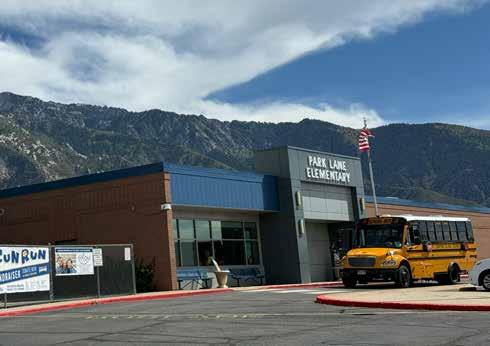



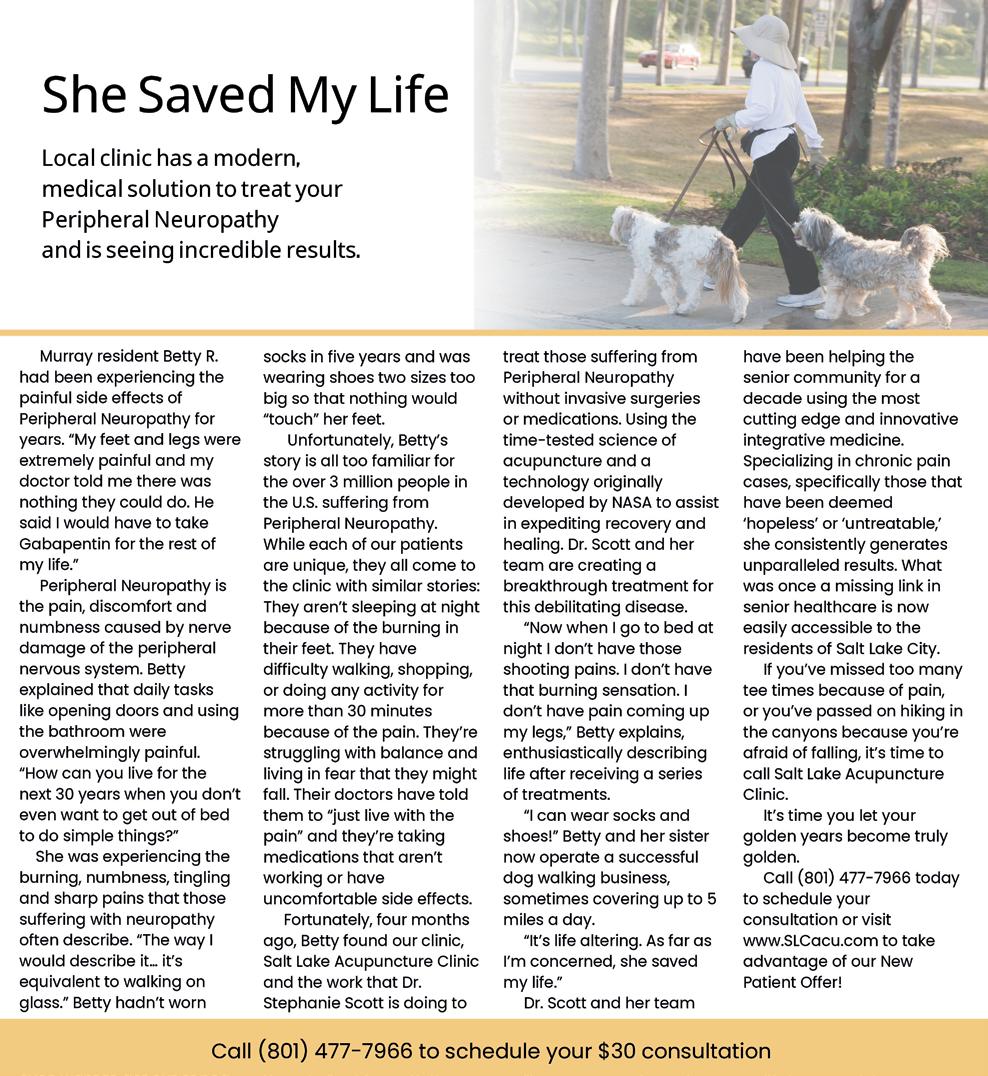

Holy Cross Hospitals have been trusted by Utah families since 1875.
For 150 years, Holy Cross Hospitals have cared for Utah families in their most tender, powerful, and vulnerable moments. From newborn checkups to post-op recoveries, we’ve seen generations through their highest highs and hardest days.
We’ve done it all with one purpose: to treat people, not just patients. We care for every person with personalized treatment powered by compassion and respect.
Our belief that we all hold the power to heal helps us provide care that spans generations and stands the test of time.
Learn more at mountain.commonspirit.org/holycross150.


ty members can provide feedback at scheduled board meetings or through the District website, where comments will be shared with both the board and the planning committee.
Three public hearings have been scheduled:
• 6 p.m., Oct. 15, board members will
said the District considers 560 students to be the optimal elementary school size, with approximately three classes per grade level.
He cited several reasons behind the recommendation, including a 9.24% decline in elementary enrollment the past five years and a 49% increase in average home values in the District during the same period, making it more difficult for families to afford to live within the District’s Alta, Draper, Sandy, Midvale, Cottonwood Heights and White City boundaries.
Other contributing factors include lower birth rates, limited residential growth, and increased alternatives such as charter schools, homeschooling and the state’s school voucher program.
While the decision is difficult, several board member pointed out it’s one the board must consider to act responsibly with District finances.
cation support professionals as well.
Although no decisions have been made about how to use vacated school buildings, Pedersen said the District plans to retain the properties “so that as bond payments drop off in the next four to five years, we can begin rebuilding our old elementary schools. We would house the students in the empty buildings while new ones are built. We also don’t know if our student populations may begin to grow again and we will need those schools.”
Wilcox added this is likely just the beginning of an ongoing process, as student enrollment is projected to continue declining into the early 2030s. Future elementary school rebuilds may be needed.
Proposed boundary adjustments
Wilcox said keeping neighborhoods intact and aligning school feeder systems were key priorities in the committee’s boundary recommendations.
meet with Granite, Park Lane and Willow Canyon elementaries’ communities at Granite Elementary, 9760 S. 3100 East.
• 6 p.m., Oct. 16, they will meet with communities from Bella Vista, East Midvale and Ridgecrest elementaries at Bella Vista Elementary, 2131 Fort Union Blvd.
• All other proposed boundary changes will be discussed at the 7 p.m., Oct. 30 meeting at the District office’s Canyons Center, 9361 S. 300 East.
Each of the upcoming hearings are scheduled for one hour.
Following these hearings, Canyons board member Karen Pedersen said a second, likely revised, proposal will be presented at the Nov. 11 board meeting.
A third reading and vote are expected in December. According to state law, school closure decisions must be finalized by Dec. 31 if they are to take effect the following school year.
Committee process
The committee evaluated eight elementary schools: Bella Vista (Cottonwood Heights), Brookwood, East Sandy, Granite, Oakdale, Park Lane, Quail Hollow and Willow Canyon (all in Sandy). No middle or high schools were included.
Factors considered included enrollment trends, building age and condition, school capacity and existing specialized programs such as dual language immersion, accelerated studies and special education.
Wilcox emphasized that the primary goal is maintaining high academic standards and opportunities for students. He
According to the committee’s report, the average cost to operate a Canyons elementary school is $1.3 million annually.
Patron concerns
Some parents and community members raised concerns even before the proposals were publicly announced, citing strong school communities, an accelerated timeline, the request for transparency, the need to listen to parents as resources and questions about the District’s financial priorities.
Bella Vista parent Juliana Jackson pointed out discrepancies in District spending.
She said District-level expenses total $202 million, while Bella Vista, which doesn’t have an assistant principal, costs $1.2 million to operate. Jackson added that the District’s overhead accounts for 38% of its $535 million revenue, whereas Bella Vista’s operations make up 0.2%.
“District-level expenses far exceed elementary school costs and are the real burden to taxpayers,” she said at the board meeting. “This is where the cuts should happen.”
She also expressed concern Bella Vista would be the third elementary school closed in Cottonwood Heights and said closing the recently upgraded school — improved with bond funds approved by voters — “would be a waste of taxpayer dollars and betrays our votes.”
Personnel and property
Wilcox said the District’s goal is to retain all employees, with most teachers moving with students to their new schools. With ongoing retirements and resignations, he expects there will be openings for edu-
Some of the proposed boundary changes include:
• A portion of Ridgecrest shifting to East Midvale
• Parts of Granite moving to Willow Canyon and Lone Peak Elementary
• The Quarry Bend area relocating from Glacier Hills Elementary to East Sandy Elementary
• All Brookwood Elementary students, and some Oakdale Elementary students east of Highland, attending Albion Middle
• All Silver Mesa students moving to Union Middle and eventually Hillcrest High
• Some students currently attending Albion Middle would shift to Eastmont Middle to align with Jordan High
• Some Eastmont students would move to Indian Hills Middle to match Alta High’s boundaries
• All Sprucewood Elementary students would attend Indian Hills Middle
• Adjustments between Brighton and Hillcrest High School boundaries
Another change affects busing. After the 2027-28 school year, the District will no longer provide west-of-interstate transportation to Indian Hills for students living in the Mount Jordan Middle boundary. Currently, about 175 students permit to Indian Hills.
Wilcox added students are allowed to apply for enrollment at any Canyons school. Those affected by boundary changes will receive preference during open enrollment, though students wanting to remain at their current school after a boundary shift will need to submit a permit application. l


Dr. Hararah, a triple board-certified physician, completed his residency in Family Medicine at NYU Langone and a fellowship in Undersea and Hyperbaric Medicine/Wound Care at SUNY Upstate University Hospital. With additional training in Bariatric Medicine and certification from the American Board of Obesity Medicine, he brings expertise in primary care, dive medicine, bariatric medicine, and clinical hyperbarics.
A firm believer in the biopsychosocial approach, Dr. Hararah views patients as complex individuals whose lives and experiences shape their healthcare. Known for his compassionate care and dedication, he listens intently, prioritizes your well-being, and works to find the best diagnosis and treatment plan.
As the owner of Blackstone Medical, Dr. Hararah is committed to helping you achieve your best health.
• Annual preventative physical exams
• Cancer screening
• Sick visits
• Specialist referrals
• Medication refills
• Chronic disease management
• Chronic, non-healing wounds
• Acute, minor wounds
• Diabetic foot ulcers
• Venous ulcers
• Arterial ulcers
• Pressure injuries...and more!
“Dr. Hararah understands the daunting and sometimes demoralizing feelings health care sometimes causes, and wants patients to be truly seen and valued as human beings.”


As part of their Utah Studies class, students explore the state’s Olympic legacy and share ideas for its future.
By Julie Slama j.slama@mycityjournals.com
This year’s Indian Hills seventh-graders may already be counting the days— but not for summer break. Instead, they’re looking forward to Utah hosting the 2034 Winter Olympics, while learning about the state’s role in the 2002 Games as part of their Utah Studies class.
The course covers Utah’s geography, Native Americans, pioneers, statehood, government, modern events, land use, the Great Salt Lake and Bears Ears National Monument. But the Olympics is a highlight.
“The first thing I did after being hired was to see if the Olympics were part of the state standards,” said history teacher Amy Shaw. “I love the Olympics and since it’s such a big part of Utah’s modern history and its future, my teaching partner, Ms. (Kamil) Harrison, and I decided it would be cool to take elements of the past, teach them about 2002 but then also have them create something for the future Olympics.”
When Shaw and Harrison began teaching the unit, Salt Lake City had only expressed interest in hosting the games again. Now that it’s official, student interest has grown.
“Now that it’s official, the kids are even more excited because they realize, this is going to be happening,” Shaw said. “They’re going to be 20, 21, 22—an age when they can attend the games and maybe volunteer.”
Shaw starts the unit by introducing her students to Olympic basics—theme, logo, mascots and medal design, with examples from the 2002 Games.
On one day, she shows a video explaining Olympic pictograms and compares them to Salt Lake’s, which combine cattle brands and Native American petroglyphs.
“We talk about what pictograms are, what their purpose is, especially for other countries, who don’t speak English or French or wherever the Olympics are going to be,” Shaw said.
Students also learn about the cauldron, torch relay, team uniforms and collectibles and see examples, both by video and some, in person.
“Some very common collectibles that are sold often during Olympic Games would be things like key chains, magnets, spoons, T-shirts, hats, lanyards, charm bracelets, shoes, cups, stickers, patches, PEZ dispensers and a whole bunch more,” she said to students. “During Olympic

Games, people from around the world come. It’s not just the people from the host country, who are collecting, it’s the visitors who want to bring something home to remember the Olympics.”
Among the most traded items are Olympic pins, which Shaw says have a life of their own.
“Pin collecting is the unofficial spectator sport of the game, because it is so popular. It started with athletes trading pins with each other, and over time, it spread to the spectators. People from around the world wanted to get in on this. Now people want to buy, sell and trade pins. It is a huge business,” she said.
Shaw owns more than 1,600 pins from the 2002 Games. She got her first—a Build-A-Bear Olympic pin—at age 4 when she saw some Olympics events in Utah.
“A lot of pins depicted Utah’s landscape, different mascots, sponsorships, sporting events, holidays and count down pins to get people excited the Olympics were coming,” she said. “Almost every school had an Olympic pin. Pins also represented a lot of funny cultural stereotype things, weird things that Utahns do, including foods like funeral potatoes and fry sauce that are unique to our state.”
Shaw brings her collection—including the rare green Jell-O pin—for students to examine, along with volunteer uniforms, the 2002 torch and other memorabilia.
“When I got to this job, we talked about mascots and I thought it would be cool to have stuffed mascots for the kids to see and touch. It makes everything more real for them to see everything,” she said. “I started buying stuff for that reason. I appreciated the Olympics being here and the history that comes with it. With all the pins that we had, I wanted to get some, especially about Utah culture, like the green Jell-O pin, because I love our state; we’re
her more, especially about the 65-day torch relay.
“It began in Greece, like all torch relays, but it went almost the entire length of the U.S., 46 states, before ending up at the cauldron,” she said. “I want to volunteer with the figure skating and see Team USA at the opening ceremonies in 2034.”
Evan Glad appreciated the design of the 2002 cauldron.
“It was really cool that it had flames and water at the same time,” he said.
Oliver Lundell, who wants to volunteer at the downhill ski venue, enjoyed the creative aspect and symbolism of the project.
“It’s fun designing everything for the 2034 Olympics,” he said. “My theme is ‘Work hard so you soar’ and my medals will have an American eagle, and I’ll include something in with it from Utah.”
so quirky.”
The project culminates in students designing their own vision for the 2034 Winter Games. Each creates a packet that includes a theme, logo, mascots, medal and cauldron designs, uniforms, pictograms and collectible ideas.
“This allows them to apply history and put creativity to work. They’re thinking outside the box,” Shaw said.
As she reviewed their work, Shaw reminded one student, “You’re making a Winter Olympic uniform, not a summer one. They need hats, scarves and coats to be bundled up.”
Shaw also encouraged students to think about their cauldron lighting choices.
“The final person in the relay carries the torch to light the cauldron and usually is significant in the Olympics and the person’s identity is kept a secret. In 2002, it was the 1980 gold-medal men’s hockey team who upset the favorite Soviet Union team during a tense political time. They were nicknamed ‘Miracle on Ice’ for overcoming adversity to achieve something seemingly impossible. It brought about great American pride,” she told students.
Students were inspired to imagine the future of the 2034 Winter Games.
Seventh-grader Hadley Waddell chose the theme “Testing the Limits.”
“Back then, it was the first big event after 9-11 and our world changed and Salt Lake City adapted to change with it; our athletes honored those lost on 9-11 carrying the big flag from the World Trade Center,” she said. “I’ve watched a lot of the competitions at the Park City Olympic Museum, but it will be cool to see all the events in person, like cross country skiing and short track speed skating.”
Maddie Mathews knew a little about the 2002 Games from her father working with the medical staff, but the unit taught
Shaw emphasized that this is more than just an assignment.
“You never know; the Salt Lake Olympic Committee may be asking people’s input, like they did in 2002, and this time, it could be your ideas,” she said. “This is a real cool opportunity.” l

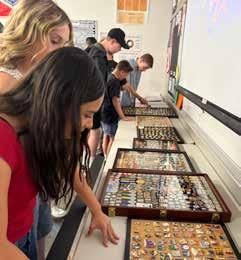
From historical fiction to fantasy, students tackled every genre—and came away with memories, certificates and a deeper love for reading.
By Julie Slama j.slama@mycityjournals.com
The excitement was unmistakable as Eastmont Middle’s Team Peeta finished each other’s sentences and laughed over their favorite reads. Their enthusiasm matched their success: they had just won Canyons School District’s Book Blitz, beating Butler Middle’s We Love Dictionaries and Indian Hills Middle’s All About Books.
Book Blitz challenges middle school teams to read a curated list of books across genres, then compete by answering questions using book titles—and, when possible, authors. A similar competition, Book Blitz Jr., is held for elementary students.
The book lists are available during the summer and students are already reading for the 2025-26 competition.
Eastmont eighth-grader Tawny McEntire started early, reading through the list last summer. Her teammates split the remaining titles in the fall.
Eighth-grader Mary Halladay credited their friendship to a love of reading—ranging from historical fiction to fantasy—for their win.
“We’re all best friends, and we did it to have fun since we like to read books,” she said. “We work well together, and we all just trust each other enough to go with what other people decide what the answer is.”
Eighth-grader Caraline Herzog added: “We talked things out and listened to each other, that’s important.”
Preparation was key. Tawny created 30 pages of study questions and attended every practice.
“Our team chemistry was a lot better and supportive because we practiced,” she said.
Naming the team was easy, said teammate Millie Rich.
“We were watching ‘The Hunger Games’ and said as a joke, we all are on Team Peta so that’s what we called ourselves,” she said, pointing to their team shirts with a “Studio C” parody quote on the back. “We laughed a lot, but we learned too. ‘Fallout’ was a phenomenal book. I didn’t think I would like it because it’s nonfiction, but I learned more than I think a lot of Americans know about our history.”
Midvale Middle School teacher librarian/media specialist Judy Rembacz sees the impact of Book Blitz.
“It’s exciting when everyone is reading books, sharing what they read with oth-

ers,” she said. “They love the competition quizzes, seeing what they know, and it’s good to see how they support one another.”
Mt Jordan Middle teacher librarian Jana Mumford helped with Book Blitz Jr.
“Getting books in kids’ hands is a win and they love the competition aspect,” she said. “I love seeing the younger grades have fun with it. Their enthusiasm feeds right into our programs at the middle school.”
Each middle school brought two teams to the District competition. At the elementary level, 19 schools participated with more than 700 students.
District Library Media Specialist Gretchen Zaitzeff, who organizes the program, praised the teamwork.
“The sportsmanship amongst the teams has been stellar,” she said. “And cheers should go out to the parent volunteers, who along with the school facilitators and coaches, have been working all year with our students to be successful at all the levels.”
Sandy Rotary has supported Book Blitz Jr. for two years.
“Locally, we help our community’s youth and focus on education so Book Blitz fits perfectly,” Sandy Rotary President Brenda Suta said. “We know these kids are the future and education uplifts them to learn and solve things in the world.”
This year, a four-way tie in the early rounds led to a playoff. Peruvian Park, Ridgecrest and Willow Canyon shared the
win, with Alta View as runner-up. All four teams received books and book bags.
Ridgecrest fifth-grader Safron Schneider recalled the tense tiebreaker.
“It was nerve wracking when we got called up there,” she said. “We told each other ‘We got this’ and we joked about one of the boys at our school who wore his lucky socks for us, so we thought about that and were able to focus.”
Safron, who read all 12 books, began last summer.
“‘Select’ is about a girl who is a good soccer player, and I also play it, so I could relate a lot. ‘The Last Fifth Grade of Emerson Elementary’ had a lot of fifth-grade experiences I feel a lot of fifth graders can relate to,” she said.
Aiming to become a writer, Safron values reading.
“Reading always helps me improve my knowledge of words, and I always get lost in a good plot line,” she said.
Granite fifth-grader Brent Fillerup of the “Book Bears” also read all 12 books.
“This was my first time competing and it was really good,” he said. “I wanted to read ‘Cookies and Milk’ as I wasn’t familiar with it and heard it was based on a true story.”
Willow Springs fourth-grader Kate Simons of the “Sugar Readers” was eager to participate.
“I really like books and read every day,” she said. “‘A Wolf Called Wonder’
was a fun book. It was from the point of view of wolf, which I never have thought about before.”
Her classmate, Rebekah Sutton, enjoyed both the books and the friendships.
“I liked ‘Saucy;’ it’s about a pig and I love pigs,” she said. “A lot of the competitions were close, but that’s part of the fun. I’m planning to read all the books this summer.” l
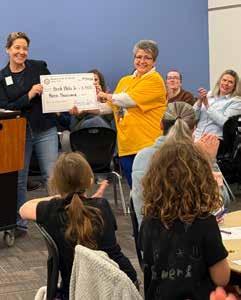


Zoltanski is fiscally responsible.

Zoltanski took over $40,000 in pay increases since becoming mayor.
Zoltanski achieved a record 700 new business licenses.
Zoltanski pushed for a tax and/or fee increases every year as mayor (except election years).
Zoltanski opposes high-density in single-family neighborhoods.
Zoltanski has recklessly grown city spending by a massive $22.9M - funding executive salary raises, extravagant gifts & flowers, food at the RSL Suite, concert tickets & more.
(Source: Sandy City budget and expense reports - FY2017-current)
Since taking office, Zoltanski has taken three pay raises—$17,807, $12,440, and $10,453—totaling $40,700.
(Source: Records request made by Sandy City resident since Monica
Sandy has lost 2,334 businesses under Zoltanski’s watch. Thats 320 less businesses than when she took office. Zoltanski’s record is one of economic decline.
(Source: Sandy City budget reports - FY2017-current)
Zoltanski pushed for a 42% tax increase in 2022, a 32% tax increase in 2023 and fee increases in 2024.
The City Council declined her 42% tax increase and slashed her unnecessary 32% tax increase proposal.
(Source: Sandy City budget reports (FY2021-current) and city council recordings)
While Zoltanski claims to oppose density, her new Pace of Progress plan INCREASES DENSITY across Sandy City, including in single family neighborhoods.
(Source: Sandy City Pace of Progress plan)
Transparently Paid for by Residents for Sandy’s Future
The reminder of 9/11 was once again part of the Utah Healing Field on the Sandy City Hall Promenade.
By Tom Haraldsen and Julie Slama
Each September as a memoriam to the victims of 9/11 and the first responders killed 24 years ago, volunteers place over 3,350 flags near Sandy City Hall. Utah’s Healing Field and Fallen Field, on the City Hall Promenade, was once again site where more than 600 volunteers placed U.S. flags that were on display from Sept. 9-15.
Although Sean held a job, his true dream was to become a teacher like his mother. A gifted athlete, he played high school football, earned 50 medals in swimming, and captained Loyola College’s rugby team.
At 23, Jennifer was working and happily engaged to a student at the police academy. Timothy was described as “the most devoted father you can imagine,” not only to his three young daughters, but also to the girls on the soccer teams he coached.
Anthony, originally from Sicily, immigrated to the United States at age 18. He and his family had just celebrated their 40th wedding anniversary days before the

since that day,” said Susan Wood, public information officer for Sandy City, in a release. “Each year Sandy asks for volunteers from the community to help place the flags and remove them after the event. This year’s volunteers included people from local businesses, scouting programs, neighborhood and church groups, and United and Delta airline pilots.”
For 23 years, the Utah Healing Field — in collaboration with Colonial Flag — has paid tribute to those who perished with the help of those volunteers who this year included individuals, church groups, Girl Scout troops, school groups such as Alta High’s National Honor Society and Mt. Jordan PTSA this year, and many others to assemble, raise and retire the flags.
In addition, the Sandy Police and Fire Departments contributed by installing the Utah Fallen Officers’ Field, providing the community the opportunity to reflect on the sacrifices made by local heroes.
tragedy of Sept. 11, 2001.
These are just a few of the many lives lost 24 years ago, remembered and honored with one of the 3,350 flags displayed.
“Each represents someone who lost their life during the attacks on 9/11/01 or a Utah police officer or firefighter killed in the line of duty
Wood said the solemn display in Sandy City was the first Healing Field in the nation erected in 2012 to honor the lives lost in the terrorist attacks of 9/11. The Healing Field represents 2,977 victims of those terrorist attacks. It was located at 10000 Centennial Parkway. l

In Sandy, eight candidates are campaigning for a seat on the city council. You’ll learn more about each of them as you continue to flip through this Voter Guide.
• Cyndi Sharkey & Monica Zoltanski are running for Mayor.
• Brooke Christensen & Shana Davis are running for District 1.
• Iva Williams & Kris Nicholl are running for District 2.
• Evan Tobin & Brooke D’Sousa are running for the At-Large seat.
Throughout the greater Salt Lake County area, voters are encouraged to pay attention to important calendar dates (like mail-in deadlines) and locate the most convenient ballot drop box.
Residents have a few different options to submit their ballots, after receiving their ballot and prepaid envelope in the mail close to two weeks before the election date.
For voters planning to vote-by-mail, ballots must be received by 8 p.m.. on election day (postmarks don’t count). In other words -- mail early.
In previous election cycles when residents were able to postmark their ballots on the day of the general election. Per the recently passed H.B. 300, voters do need to make sure their ballots are physically ‘in-hand’ at the Salt Lake County office on election day.
While registered voters do have the option to send in their vote-by-mail ballot before Nov. 4, they also have the option to vote in person. Check the accompanying list of Vote Box locations to find the ballot box nearest you. Similar to mail-in voting, ballots must be dropped off before 8 p.m. on election day.


Hey Voters! Please review the following voting information directly from Salt Lake County before submitting your ballot.
Nov. 4 is the General Election - Vote Centers and drop boxes will close promptly at 8:00 p.m.
Important Dates
Oct. 10 - Salt Lake County will host Logic & Accuracy Tests where the public is invited to attend live demonstrations of voting equipment.
Oct. 14 - Ballots being to be mailed (21 days before the election as per Utah’s legislation).
Nov. 18 - Board of Canvassers Meeting where each city will certify results after presented to the City Recorders.
Vote Box locations:
Residents can vote by mail or in-person at various drop box locations throughout Salt Lake County:
County - Salt Lake County Government Center (2001 State St.)
Cottonwood Heights - City Hall (2277 Bengal Blvd.)
Draper - City Hall (1020 Pioneer Rd.)
Holladay - City Hall (4280 S. 2300 E.)
Herriman - City Hall (5355 Main St.)
Midvale - City Hall (7505 Holden St.)
Millcreek - Common (1354 E. Chambers Ave.)
Murray - Post Office (5025 State St.)
Sandy - City Hall (1000 Centennial Pkwy.)
Sandy - Senior Center (9310 S 1300 E)
South Jordan - City Hall (1600 W Towne Center Dr.)
South Salt Lake - Granite Library (331 S. 500 E.)
Riverton - City Hall (12830 S Redwood Rd.)
Taylorsville - City Hall (2600 W Taylorsville Blvd.)
Wet Jordan - City Hall (8000 S Redwood Rd.)
West Jordan - Ron Wood Park (6000 W New Bingham Hwy.)
West Valley - City Hall (3600 S Constitution Blvd.)
Register to Vote:

Voter Registration website
Residents can register to vote online up to 11 calendar days before the election (before 5pm). Registration must be submitted and received before Tuesday, Oct. 28 to receive a ballot in the mail. A valid form of ID, accurate address information, and date of birth is required to register. Residents can register either: online by visiting the State of Utah’s website (see adjacent QR code); through mail by filling out the Formulario de Inscripcion por Correspondencia Para Votantes (Voter Mail-In Registration Form) found on the County’s website; or in-person at the 2001 S. State St. office. Same-Day registration options will also be available at vote centers. Learn more about voting information through Salt Lake County’s website at: saltlakecounty.gov/clerk/elections. Or by directly emailing: vote@saltlakecounty.gov.
Sourced
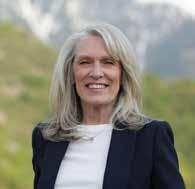
Do you believe current property tax revenue is being used effectively? How so?
Thinking about fiscal responsibility - What values should your local budget reflect? How do you plan to balance those values?
Property tax revenue is only one source of income to our city. I’m a strong supporter of economic growth, rather than property tax, as a means of funding city services. I’ll always look for ways to balance the budget without putting undue burdens on Sandy residents. That’s why I’m the only candidate in the race endorsed by the Utah Taxpayers Association. Unfortunately, the current mayor has advocated for property tax increases every year (except the current election year) to cover ballooning budgets. Taxes have increased under this mayor more than any in Sandy City history. While costs rise and essential services must be funded, taxpayers are being crushed by increasing costs everywhere. My job is to hold down rising costs and look for other ways to balance the city budget rather than the default of annual tax increases. That’s why I’ve voted against 3 property tax increases, and a sales tax increase as your council member.
Citizen surveys tell us what to prioritize: public safety; parks, recreation, and open space; well-maintained streets; safe and quiet neighborhoods; and reliable services like fresh water and trash collection. But there are places to cut spending, and I’m known for being a fiscal conservative.
Sandy’s budgetary values must reflect the desires of the community. That’s why resident input is so important to my service as a council member of six years, and as your mayor. My goals must reflect your priorities.
One goal that Sandy families value is low taxes. As an elected official, that means to me that we should fund all essential services and needs of our residents and businesses, while doing it with fiscal restraint, and with consideration for all income levels. With every expenditure under consideration, I always ask myself “If the taxpayers knew about this expense, would they be okay with it?”
There’s something they’re not okay with – and that’s the mayor’s salary. Our current mayor is the highest paid in Utah. Not only that, she has accepted salary increases totaling more than $40,000 in just 4 years in the job. If elected, I will turn the clock back to 2017. I will accept the pay rate of 8 years ago, before we had a mayor who gave himself a $15,000 pay raise, and another who accepted a $14,000 pay increase in one year alone. I will return to a time before taxpayers were funding big mayoral pay raises.
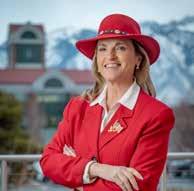
Yes, our tax dollars are spent wisely and mirror Sandy values. Each year I work with finance experts, department heads, elected officials and community advisors to champion our shared budget priorities. Once the City Council approves the budget, residents know that every expense – whether it’s vehicles and equipment, community events, staffing or even curbside bulk waste pickup – is publicly vetted and approved with community input.
City needs always exceed revenue. That’s why I actively seek out and promote businesses to organically grow our tax base. I’ve brought home over $35 million in outside funding for roads, bridges and infrastructure to reduce our tax burden. This year, I aggressively trimmed $1.1 million from the budget by eliminating 5 staff positions. We do more with fewer employees today, than in 2009.
This is how I responsibly meet our core functions of public safety, community engagement and economic development. The proof is in the results. Sandy residents are proud of our city’s direction as we continue to land major sports investment, and improve infrastructure with the long-overdue new main fire station, public works garage and recreation center. It’s not enough we manage for today. A well-run city is about preparing for Sandy’s tomorrow.
Our Sandy community values safety, transparency, responsive leadership, and responsible growth—and our city budget reflects those values. Fiscal responsibility requires every tax dollar supports city services like public safety, emergency preparedness, maintaining parks and trails, curbside bulk waste pickup, and strengthening our community .
We invest in our workforce, plan for the long term, and protect what makes Sandy unique—strong neighborhoods, open spaces, and historic areas. As we face growth and rising housing costs, I work to balance today’s needs with long-term planning to preserve the character of our city while preparing for the future.
I lead with integrity—showing up not just for marquee moments or high-profile events, but for the daily rhythm of city life. I value the opportunity to listen, learn, and work alongside residents and community leaders....
What systems would you support to hold local officials accountable when transparency standards aren’t met?
We live in a time of low trust in elected officials and governmental institutions. Ethics, honesty, and accountability are my highest priorities. We don’t have to agree all the time, and that probably isn’t a realistic goal, but residents and businesses in Sandy need to feel represented, heard, and valued – all residents and businesses, not just some.
I won’t cater to special interests, or certain groups. My job is to fairly and equitably address the needs of ALL of Sandy. Unfortunately, that’s not the current state of affairs. Under the current administration, certain neighborhoods enjoy benefits, perks, or special consideration while others are ignored.
There are certain advantages allowed in the current mayor’s neighborhood, but nowhere else in Sandy. In this administration’s new General Plan (The Pace of Progress) the mayor’s neighborhood is protected from increased density that is imposed across all the rest of Sandy’s neighborhoods. I voted against it. The mayor’s neighborhood is allowed to run businesses that aren’t allowed anywhere else in Sandy. I voted no. How can one be trusted if they won’t be fair?
My responsibility is to make good decisions on behalf of all 95,000 and 6,000 businesses in Sandy, not just special groups.
Transparency is the cornerstone of public trust—and a daily priority in my leadership as Mayor. Residents deserve open access to their government, timely information, and clear opportunities to be heard.
How I’ve delivered:
• Land Use Notification Reform: As a City Council member, I led the push for new bright orange public notice signs at rezoning sites—bringing land use decisions into plain sight.
• Mayor’s Hotline: My new dedicated hotline (801-568-6060) ensures every message receives a response within 24 hours.
• Open Office Hours: I host monthly office hours so any resident can speak with me directly.
• Gondola Survey: My first act as mayor was launching a citywide survey during my inaugural speech. The results—strong public opposition—continue to guide my stance on canyon transportation.
• Pace of Progress Plan: I led a 2.5-year public engagement effort for our new general plan, involving over 250 meetings and thousands of resident comments.
• Proactive Communication: From daily social media posts to a city-published newsletter reaching every household, I use every channel possible to keep residents informed....
Sourced directly from our readers
Do you believe current property tax revenue is being used effectively? How so?
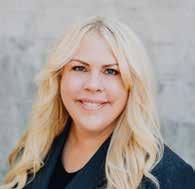
brooke4sandy.com
No, I don’t believe the property tax revenue sent to Salt Lake County is being used effectively. The county’s structure may have been necessary in the past, when there were many unincorporated areas, but that’s no longer the case. As those areas have been absorbed into existing cities, this additional layer of government has become redundant. Roughly 17% of your tax bill goes to Salt Lake County compared to 11% going to Sandy City.
The responsibilities currently managed by the county could be redistributed more efficiently. For example, the health department could be transferred to the state level, and county facilities and parks could be turned over to the cities they are located in, along with the corresponding tax revenue to maintain them. Project funding could be allocated directly to cities based on population. Eliminating unnecessary county positions would result in significant cost savings and allow for more direct, efficient use of taxpayer dollars.

shanaforsandy.com
One hundred percent of Sandy City property tax goes toward the Public Safety budget.
Thinking about fiscal responsibility—what values should your local budget reflect? How do you plan to balance those values?
If you want to know what a city values, look at how it spends its money. Sandy City’s General Fund has approximately $82 million in revenues budgeted for FY2026. Seventy-four percent of it is spent on personnel, 8% is transferred to other funds ($2M to Alta Canyon, $2.6M to Capital Projects), 7% to internal services (fleet, IT), and 6% to materials and supplies. With so much of the Sandy budget going to pay the people that keep the city running, there aren’t many discretionary funds to allocate. I would like any large capital expenditures to be voted on by the public, that way bonds are only entered into when the majority of the public agrees. I personally think essentials are the priority: police, fire, snow removal, public utilities, etc.
The budget should reflect accountability, transparency and reward for performance. Each department should be held accountable for their stewardship. If they perform very well, they should be rewarded to encourage them to stay with Sandy City and continue to provide quality service for our citizens. Each department should be held accountable and should reconcile any variance from their budget.
What systems would you support to hold local officials accountable when transparency standards aren’t met?
What is your stance on local government cooperation with ICE?
The main responsibilities of Sandy City Council members are: legislative authority, budget oversight, community representation and strategic planning. It is crucial for this to happen to keep all three branches of our city government in check. Transparency must be more than a buzzword. It requires real tools, regular oversight, and accountability systems that don’t depend on whether people are paying attention. The yearly independent audit, quarterly budget reviews, and annual departmental budget reviews are tools that help. I’m committed to supporting policies that make our local government more open, honest, and responsive to the people it serves.
I believe local governments should cooperate with federal and state authorities, including ICE, in accordance with the law. Local agencies should not obstruct or ignore lawful requests from federal immigration enforcement. That said, any cooperation should be done within the bounds of the Constitution and with respect for due process. It’s important to maintain public safety while also upholding individual rights and ensuring local resources are used appropriately.
If voters feel transparency standards are not met then they should hold them accountable with their votes. However, rather than wait for an election, let’s make sure our citizens know about city council meetings, how to participate in person or via Zoom, allow public comment, etc. (which is the current standard). Every citizen should be aware of how to participate or view city council meetings.
Sandy City Police will not obstruct or facilitate any operations by ICE. I have full confidence in our public safety department to uphold the laws of the United States Constitution, the laws of Utah and the laws of Sandy City.

Do you believe current property tax revenue is being used effectively? How so?
Thinking about fiscal responsibility—what values should your local budget reflect? How do you plan to balance those values?
In Sandy, yes. I believe our property taxes are being used effectively— especially in funding essential services like police and fire. The new firehouse was a much-needed addition to our community. I also believe most residents support services like our twice-yearly bulk collection program. As a resident myself, I’m proud to contribute taxes that support our recreation, parks and open spaces. These services enhance our quality of life and help build a vibrant, connected community.
I believe a city’s budget should reflect the values of community, equity and long-term sustainability. Public dollars should be used to uplift and protect every member of our community, not just today but with the future in mind. I would prioritize needs like public safety, infrastructure, affordable housing and environmental stewardship—while ensuring community voices guide where and how we invest. Balancing the budget requires listening, transparency and a clear vision for where we’re going.

There are areas where tax dollars are not being spent as effectively as they should be. While some spending is essential, I see redundancy in parts of the budget and expenses that do not directly benefit residents like upgraded flights, extra snacks or paper periodicals. Taxpayer dollars should be treated with the same care that families use in their own household budgets: focusing on needs, not wants. There are always ways to cut unnecessary costs without sacrificing employee pay or the quality of life for residents. By prioritizing core services like public safety, roads, parks, and clean water, and trimming back on less essential spending, Sandy can stretch every tax dollar further and keep property taxes under control.
Our city budget should reflect the same values families use at their own kitchen tables: responsibility, prudence and prioritizing needs over wants. Taxpayer dollars should go first to core services, public safety, roads, clean water and parks—that directly impact residents’ daily lives. At the same time, we need to identify and cut redundant or unnecessary spending, such as perks or extras that do not improve residents’ quality of life. By eliminating waste, we can protect employee pay, maintain essential services, and keep Sandy affordable without constant tax increases....
What systems would you support to hold local officials accountable when transparency standards aren’t met?
What is your stance on local government cooperation with ICE?
I fully support Sunshine Laws, open meeting requirements and public access to records. I also believe in independent ethics boards or commissions that have real authority to investigate and hold officials accountable when transparency is compromised. Clear, enforced standards are essential to maintaining public trust.
I oppose local police being used to enforce partisan federal immigration priorities. Our local resources should focus on protecting our communities, not advancing divisive policies. Trust between law enforcement and the community is essential to public safety.
Transparency is not optional—it is the foundation of public trust. Sandy already strives to make every bit of information available to taxpayers, and I believe that commitment must be strengthened. I would support systems that ensure residents have easy, timely access to budgets, contracts and meeting records. If transparency standards are not met, there must be clear accountability. That means regular audits, open data portals that show how tax dollars are being spent, and strict reporting requirements for elected officials. It also means setting policies where violations of transparency are addressed swiftly and publicly, not quietly.
Local governments are not legally required to assist ICE, and I am not aware of any Sandy City policy that mandates our offices to do so. My focus is on ensuring that our city resources are directed toward local priorities, public safety, infrastructure, parks and essential services for residents.
I believe in following the law as it applies to cities, but I do not support using local tax dollars to expand beyond our legal responsibility. Our police and city employees should remain focused on protecting our community, keeping neighborhoods safe, and providing the services residents expect from their local government.
How will your stances on specific issues impact Sandy and the community?
I believe Sandy’s top priorities should be public safety and environmental stewardship. Ensuring our police and fire departments are well-supported keeps our community safe and our first responders engaged and valued. My focus on preserving our natural resources—especially water, open space and land—will shape how we allow new development. Sandy can grow while still protecting what makes it special by rewarding responsible, community-aligned development.
My approach to every issue is rooted in open, honest communication with residents and addressing challenges head on. Sandy deserves leaders who do not avoid tough conversations but instead engage with the community directly and transparently.
By being clear about my stances whether on fiscal responsibility, public safety, transportation or protecting our neighborhoods residents know exactly where I stand and how I will represent them. This builds trust and ensures that decisions are made with the community, not behind closed doors.
The impact on Sandy is simple: stronger accountability, smarter use of resources, and policies that reflect the values of the people who live here. When residents can count on their leaders to be straightforward and accessible, the entire community benefits.
Sourced directly from our readers
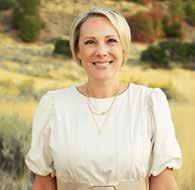
brookeforsandy.com

Do you believe current property tax revenue is being used effectively? How so?
Thinking about fiscal responsibility—what values should your local budget reflect? How do you plan to balance those values?
What systems would you support to hold local officials accountable when transparency standards aren’t met?
What is your stance on local government cooperation with ICE?
How will your stances on specific issues impact Sandy and the community?
Generally, yes, though there is always room for improvement. Budgets should prioritize core services such as public safety, infrastructure, and the employees who keep the city running. Over the last three and a half years, I’ve worked to reduce unnecessary expenses. With one effort alone, I saved Sandy taxpayers over $300,000 annually in credit card processing fees. This shows how careful oversight can make a real difference. As living costs rise, it is more important than ever for city leadership to cut spending where possible and avoid adding to the financial pressure residents are already experiencing.
Our budget should emphasize maintaining core services, ensuring long-term stability, and exercising fiscal discipline. I will continue focusing on careful spending, directing investments where they matter most, and protecting taxpayers from unnecessary costs.
Transparency in government is essential. I pushed for and created a centralized council email (citizencomment@sandy.utah.gov) so residents have a simple, direct line to all their representatives. I support legislation that increases transparency and enacts accountability measures when standards aren’t met.
Local government’s primary responsibility is community safety. Our police resources should be focused on protecting residents and businesses, and addressing local crime.
I will always work to enhance the quality of life for residents and support a strong local economy. Whether it’s protecting open space, managing growth responsibly, or safeguarding taxpayer dollars, every decision I make is guided by what benefits Sandy families today and in the future.
Bio/Experience:
I was born and raised in New York. I earned a Bachelor of Science in Applied Mathematics from Brown University, an Ivy League School in Rhode Island. I had a very successful career in information technology, co-founding Technical Computer Marketing Corporation (TCMC).
In 1979 I came to Utah and skied “The Greatest Snow on Earth”. Loving it, in 1991 I bought a Powder Ridge condo in Alta which I owned for 20 years. I have now been living in Sandy for over twenty-five years.
In retirement, I rent timeshares and condos in Alta/Snowbird.
My public service experience has included serving terms as Treasurer, President and long-term Board Member of Alta Community Enrichment, the Alta Arts Council.
Reason for running:
My Council Priorities include:
1) Solving the disaster of dangerous traffic created by winter weekends and powder days. The current UDOT/EIS solutions should not be pursued until frequent, reliable bussing alternatives have been attempted. The current extremely limited UTA bus schedule only exacerbates the problems.
What is your stance on the proposed canyon gondola?
How will you prioritize and protect proper historic restoration of existing structures?
Sandy experiences real winter traffic and safety problems that demand real solutions. I support solutions that will reduce canyon congestion while respecting our canyon and the voices of Sandy residents. I support the approved phased approach with enhanced busing and believe it should be fully implemented and evaluated before considering any future phasing. I will always advocate for the best solutions for our community, and I will defend Sandy residents from projects that impose unnecessary costs without proven benefit.
History shapes community identity. I believe in balancing progress with preservation. I’ll continue to support efforts that protect Sandy’s unique character while honoring our shared community values.
2) Sensible city planning that reflects the will and interests of the residents, not the developers! Constant zoning changes affect the quality of life in Sandy. When a neighborhood is zoned “low density residential”, residents should be able to trust that their neighborhood should not change dramatically. I believe any high-density housing and/or urbanization should only occur in “Downtown Sandy” very close to the I-15 corridor or Public Transportation.
3) Just say NO to the Gondola up Little Cottonwood Canyon !





With a season featuring studentdevised pieces as well as classics and comedies, Alta High’s theatre program helps students find their voice—and share it on stage.
By Julie Slama j.slama@mycityjournals.com
Alta High School’s theatre season promises a diverse lineup, including Shakespeare, student-devised work, a musical and a comedy.
The season kicks off Oct. 1 at 6 p.m. with A Night of Shakespeare, featuring 30 students performing scenes and monologues. Adapted by alum Lyndsey Nelson and directed by Lindsey Cline, the show serves as a preview for the 49th annual Utah Shakespeare High School Festival. Tickets are $5 and can be purchased at on the school’s website, ahs.canyonsdistrict. org/ or in the office. It will be performed school’s Performing Arts Center, 11055 S. 1000 East.
Next, they will perform a free showcase at 6 p.m., Oct. 29-30 featuring student-created work.

“The seniors are creating a devised, original work around a topic they choose,” said director Linze Struiksma. “It will be some form of oppression they see in society today and their piece will show how to talk about that in a safe manner.”
The musical “Hadestown” follows, running Nov. 19-22 and Nov. 24 at 7 p.m., with understudies performing Nov. 20. Tickets are $9 in advance or $10 at the door and $16 for the opening night gala. The show is directed by Struiksma.
“The show talks about creating the world we live in,” she said. “We talk about standing up for things which we believe are right, and telling the story we think needs to be told, to give voice to the people who might not have a voice for themselves. We analyze these characters, their choices and what we would want to like to change about the world—and how you don’t have to sit and wait for it to change. You get to help
that happen.”
Struiksma believes these are reasons why it is important students study theatre.
“Kids need to do theater, so they find their own voice and then know how to use it. We need a world with more people to do that,” she said. “I tell students when you leave my class and you’re more confident in who you are and what you believe about the world and yourself, then I’ve done my job. Yes, I want you to be a better actor, but I want you to be more confident and love who you are.”
On Dec. 12, the murder mystery dinner written by senior improv captain Taylor Fairbourn will be held at 5 p.m. and 7:30 p.m. Tickets are $16 in advance.
In the new year, audiences can enjoy the comedy “The Play That Goes Wrong,” directed by Cline, running Feb. 18-21, 2026. Tickets are $9 in advance, $10 at the door.
In spring, students will compete in regional and state theatre competitions, with a one-act and individual events.
“We are working to defend our seven-year region champ title,” Struiksma said. Also in April, the thespians will join the choir and band to attend workshops at Disneyland.
The season concludes with student-directed one-acts will be at 6 p.m., May 7, 2026. There will be about six 10-minute shows and tickets will be $5.
“It’s an awesome opportunity for them to be directors. It’s optional and they apply to direct, either alone or in pairs. I like them to have that experience, to know directing is a career option,” she said.
Alta’s drama club meets monthly and performs a February service project.
“It’s a time where everybody can bond together and spend some time outside of a rehearsal situation to socialize and make friends,” she said.
Additionally, advanced theatre students will see five professional productions, including shows at Pioneer Theatre Company and Hale Centre Theatre.
“Our kids are talented, but honestly, they’re awesome. They work hard and are kind,” Struiksma said. “It’s going to be a fun season.”. l



In today ’s turbulent times, Sandy needs strong leadership that prioritizes our highest values: honesty, ethics, transparency, and accountability.
Cyndi Sharkey is the leader that unites – not divides. She’s the one you trust to:
- Serve ALL of Sandy – not prioritize special interest groups or certain neighborhoods
- Fight for Low Taxes – voted against 4 tax increases to keep Sandy more affordable for seniors and families

- Champion Police and Fire Budgets - without unnecessary tax hikes
- Build Trust – pledges to reduce the mayor’s salary to the 2017 level, a sensible wage that restores taxpayer confidence in the Mayor’s office
- Respond to Resident Needs – saved the popular bulk waste program while her opponent twice voted against it
- Restore Civility to Politics – creating the Pledge of Fair Campaign Practices which her opponent refused to follow
- Fight for Fair Zoning - limit high density development, not impose it o except her own neighborhood
- Collaborate - will work with State to resolve Canyon transportation challenges
Endorsed by:
The Utah Taxpayers Association
Governor Gary Herbert
Representative Steve Eliason
Representative Clint Okerlund
Representative Tracy Miller
Senator Kirk Cullimore
Senator Keven Stratton
Sandy City Council Brooke D’Sousa
Sandy City Council Marci Houseman
Cottonwood Heights Council Matt Holton
Cottonwood Heights Council Suzanne Hyla
County Council Dea Theodore
Alan Matheson
Scott Cuthbertson
Stan Lockhart
Kelvyn Cullimore
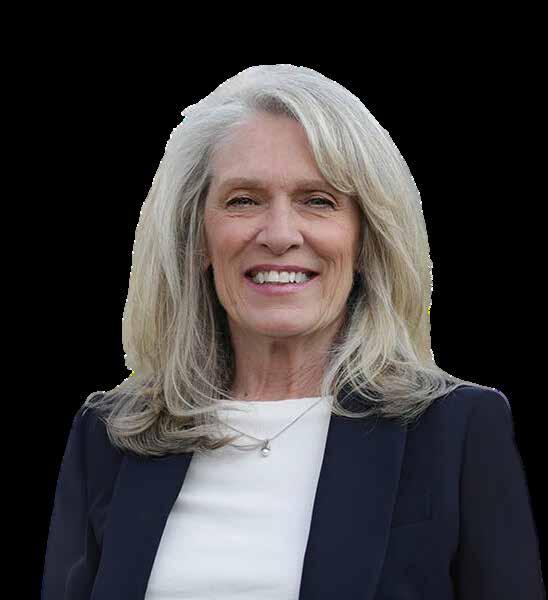
With an unfaltering sense of smell, Ca$h is a unique resource at the Sandy Police Department.
By Peri Kinder peri.k@thecityjournals.com
With more than 230 million scent receptors (40 times the number of a human nose), K9 Officer Ca$h is more than a police dog; he’s a determined detective that can track a smell through any terrain to locate a missing child, a wandering senior, a criminal suspect or a lost hiker.
Ca$h has worked as a bloodhound for the Sandy Police Department since 2019 and has been partnered with SPD Officer Graham Tinius since April 2024.
“I’ve been a cop for 21 years and always wanted to be a K9 officer, but it just never happened,” Tinius said. “When Ca$h became available, I jumped at the opportunity. He’s just a goofball. He’s a bloodhound, so it’s not the most common dog to see in law enforcement. Most officers have German Shepherds or Belgian Malinois. Ca$h is just a big, wrinkly, slobbery mess.”
Despite his goofball appearance, Ca$h is the best tracker on the force. He isn’t a cadaver dog, so he doesn’t find dead bodies, but his ability to smell for live human odors is

exemplary. He can track a person’s path or even find an item they dropped along the way, like a baseball cap or wallet.
He’s not trained to attack, unlike other K9 officers, because his job isn’t to apprehend a suspect. Unlike his pointy-eared counterparts, floppy-eared Ca$h doesn’t even realize biting is an option.
“He’s just a sweetheart,” Tinius said. “When it comes to the use of police dogs, there’s a lot of constitutional case law that says when you can and cannot deploy a dog because of the potential for an injury. You wouldn’t be able to deploy a traditionally-trained German Shepherd on a missing child or a missing dementia patient, or even a low-level crime like a shoplifter because of the potential for injury. Well, Ca$h doesn’t bite people. I can deploy him on any lost person, any person who flees from the police department, even lowerlevel crimes that the pointy-eared dogs can’t deploy on.”
Tinius and Ca$h hang out 24 hours a day, with the dog following Tinius from room to room when they’re off duty. They run errands together and have lots of one-sided conversations, so Ca$h gets used to the sound of Tinius’s voice.
Once a week, the five K9 officers in the SPD train together for an entire shift. During individual training, Tinius hides his keys or wallet or phone in different locations and tells Ca$h to find it. The bloodhound usually tracks down the items in less than 10 minutes.



Tinius also works as a homeless liaison officer, serving as a bridge between unhoused individuals and community services. He and Ca$h are often seen in Sandy doing police work, waiting for the chance to track someone.



“He loves to work. If I get out of the car, he immediately sits up in the back seat. If I move my seat forward, he gets excited because that’s where his deployment equipment is located, like his leash and harness,” Tinius said. “If he knows that we’re going to track someone, he gets very excited. He loves working. He loves doing his job.
“But when he’s not working, he’s the most relaxed dog ever. He doesn’t run circles in the back of my truck and bark. He just curls up like a little cinnamon roll and sleeps in the backseat.”
With only a handful of bloodhound K9 officers in Salt Lake County, Ca$h is a valuable resource in the department. His unique ability to track criminals or locate lost individuals makes him a significant asset, with an important role to play.
“The way that these dogs can detect odor that has been on the ground for several hours and use that ability to track people who may have memory issues or developmental disabilities or are prone to wandering or getting lost on their way home, I think it’s a wonderful tool,” Tinius said. “I’m glad that the Sandy Police Department has that with Ca$h.” l
Despite construction, Jordan High’s theatre students are staging a full season of shows, workshops, and community outreach—learning a little more about improvisation.
By Julie Slama j.slama@mycityjournals.com
While others may see chaos with the auditorium and costume closet under construction, Jordan High theatre teacher and director Suzie DuVal sees opportunity.
“Construction in the auditorium will begin with the winter holidays, so we can still perform the musical in our auditorium this fall,” she said. “However, they took our light board to Eastmont because their board had died, so I didn’t have a light board when school started. When we got our new light board and were being trained how to use it, we learned we had to clear our costume shop because the crews wanted to start working in there. So, we moved the costumes to the stage, the dressing room and the bell choir room. It’s all OK; we’re going to have some beautiful facilities once everything is done.”
The upgrades will include a new Black Box theatre. In the meantime, DuVal and her students are juggling rehearsal and performance spaces.
The season opens with “Richard III,” adapted by DuVal and directed by student teacher Leona Lombardi. The 40-member ensemble performs Sept. 30 at the school, 95 Beetdigger Blvd., before competing at the 49th annual Utah Shakespeare High School Festival in Cedar City. About 80 students will participate in scenes, monologues, dance and Tech Olympics.
The fall musical, “Cinderella,” will run Nov. 13-15 and Nov. 17 at 7 p.m. Tickets, available at the door, are $6 for students and $8 for adults. Lombardi directs with Dean Rice assisting. DuVal produces; Jennifer Humphrey choreographs with student Makayle Reid; and Jaron Putnam leads vocals. Jordan Wright will direct the pit orchestra.
“Our production of ‘Cinderella’ is going to have a lot of puppets and devising, and a lot of the magic will happen in front of your eyes. There will be a lot of dance and movement with the devising and that will give our ensemble fun opportunities,” DuVal said.
Leads include senior Kate Barnes as Ella, senior Matt Gibbons as Prince Topher, junior Evelyn Shore as Marie, the fairy godmother and junior Adam Lindsay as Jean-Michel. With 20 Eastmont Middle students in the cast, the show features 100

performers and 60 tech students. All instrumental students will learn the score, with a rotating pit each night.
On Dec. 18 at 7 p.m., students will present the Night of Broadway. Tickets are $5, with proceeds funding guest artist workshops.
With the auditorium under renovation, a student-written interactive show based on “A Day Well Spent” will be staged Feb. 19-21 and Feb. 23, 2026, in the Tech Atrium.
We
“It’s going to feel like a familiar story, but we’re kind of rewriting it with lots of new characters,” DuVal said. “We want it to be interactive so people will get up on stage and do fun things in the show. It may be dessert theater, so I think the audience will get dessert as part of their admission price.”
“We use as many student-written works as possible; last year, about three quarters of the plays were student written,” DuVal said. “We hope we can perform that next year in our new Black Box that’s being built.”
The school’s improv team, led by senior Lincoln Keele and junior Cayden Barfuss, holds weekly rehearsals and plans six shows this year. Improv falls under the umbrella of the school’s drama club led by president senior Sydney Pratley. The improv team also compete at the annual Slap Fest competition.
use as many student-written works as possible; last year, about three quarters of the plays were student written.
Suzie DuVal

“It’s really fun; they compete for judges and get feedback,” DuVal said.
Community outreach includes free middle school workshops in December and a performing arts camp on Jan. 24, 2026.
Students will perform their one-act ensemble at region in March under the direction of Rice. State is in April.
In May, the season closes with a Theatre 2 showcase on May 5 and student-directed one-acts on May 6-7, 2026.
“It started as a theater camp, but last year, with more than 100 kids signed up, we expanded it to a performing arts camp,” DuVal said. “Our drama council along with other performing arts leaders gain leaderships skills and help teach them.” l
Spooky season is approaching and for elementary schools that means combining costumes, classwork and community with safety.
By Julie Slama j.slama@mycityjournals.com
As about 600 Glacier Hills elementary students parade through a White City neighborhood in costume on Halloween morning, safety remains top of mind for Principal Julie Winfree.
“We will have police officers lead, follow and patrol intersections and we’ll have teachers, aides and extra staff with walkie-talkies walking with the students,” she said, urging parents to ensure kids wear appropriate shoes and coats. “It’s a fun opportunity for the parents and community to sit out on their driveways and see the students parade by; they line the streets.”
Still, she notes, “It’s also a day of learning so we want students to wear costumes they can learn in.”
That means no masks, weapons or facsimiles of weapons—guidelines shared across most Salt Lake Valley schools.
Luke Allen, Granite School District’s associate director of communications, said costumes must follow regular dress code rules.
Those guidelines include students must be fully dressed, with clothing that covers the body appropriately and includes safe footwear. Students also may not cover their face unless it is for religious, health or medical reasons. Costumes or clothing may not display images, symbols or language that depict obscenity, lewdness, hate, violence, drugs, alcohol, tobacco or gang-related activity, and they may not include items that could be used as a weapon. Student attire and expression also must not cause significant disruption to learning.
“Halloween can be a fun opportunity for students to celebrate together, but we remind families that costumes at school must follow the same rules as everyday attire,” he said. “Our focus is always on ensuring a safe, respectful and positive environment for all students.”
Many of Granite District’s 26,000 elementary students participate in Halloween parades, typically held outdoors, weather permitting.
Canyons School District Risk Manager Ryan Jakeman advises parents to consider different costumes for school and trickor-treating.
“Masks, which block visibility, and facsimiles of weapons are a ‘no-go’ at school,” he said, recommending face paint instead. “While costumes are encouraged, safety is also a priority for students.”
Canyons spokesperson Kirsten Stewart adds: “We’ve found outdoor parades, provided you can identify a safe route,
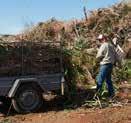
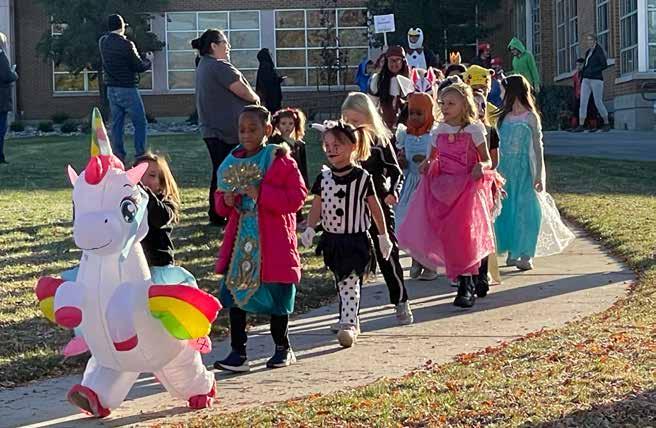
are a great way to involve the community.”
Jordan School District also has shifted most parades outdoors post-COVID.
Jordan District’s Director of Communications Sandy Riesgraf said schools typically remind families: “no masks, weapons or excessive face paint. The school staff needs to be able to identify students.”
Riesgraf added costumes should be wearable all day and follow district dress codes.
At Falcon Ridge Elementary in West Jordan, Principal Aaron Ichimura said dressing up helps build connections between students and administration.
“They get to learn we’re human and enjoy doing the same things they enjoy,” he said. “Halloween traditions are deeply rooted in Utah.”
The school holds a PTA-run festival with students rotating every 30 minutes with seasonal grade-level activities.
“We’ll send out a Parent Square message reminding stu-

dents not to wear masks, because we want to be able to identify students, no weapons or facsimile of weapons, no blood or violent costumes,” Ichimura said. “We want Halloween to be a fun time for everyone.”
Like other principals, Ichimura emphasized classroom learning.
“We encourage staff to plan learning activities, and they can be ideas linked to Halloween like stories or math so it can be a creative, fun approach to learning,” he said.
In Murray School District, individual schools set safety guidelines.
“Halloween is a fun and exciting time for our students, and we support school administrators in creating a positive and safe environment by developing traditions and practices unique to their school,” said Doug Perry, Murray District’s communication officer. “We also encourage families and the community to prioritize safety when choosing how to celebrate, both at school and beyond.” l




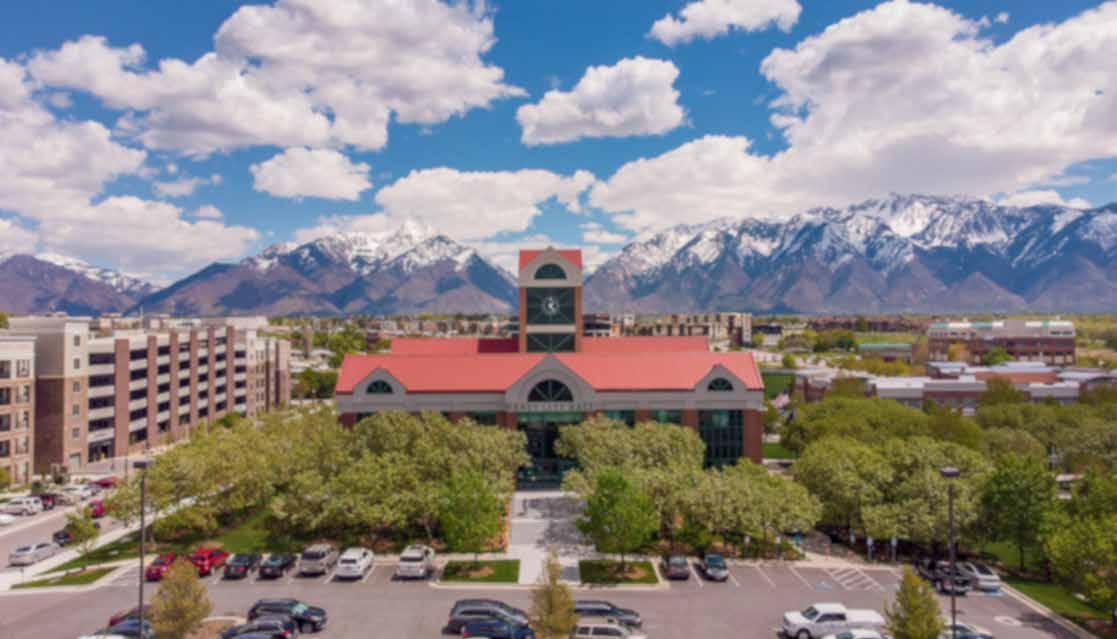
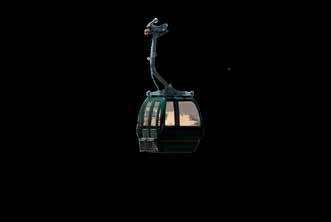







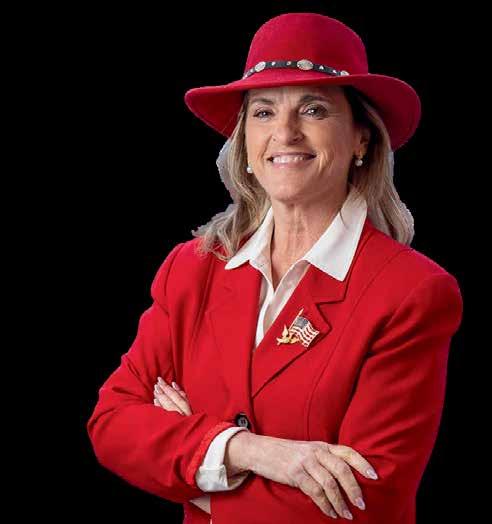

Photo By Julie Slama j.slama@mycityjournals.com
School started with remote learning because of unexpected construction issues at Eastmont Middle, but that didn’t stop sixth, seventh and eighth graders from getting the full red-carpet treatment on Sept. 2. The students were welcomed by Principal Stacy Kurtzhals, faculty and staff, the Patriot mascot, Canyons School District administration and board of education members, Jordan High drumline and cheerleaders and even Sandy Mayor Monica Zoltanski. While many students smiled and exchanged high-fives as they made their way in, one was so thrilled to be at school that she backflipped down the red carpet. Construction still is underway, updating restrooms, classrooms, library, installing a new elevator, along with final touches to the hallways, cafeteria, locker rooms and the gym.
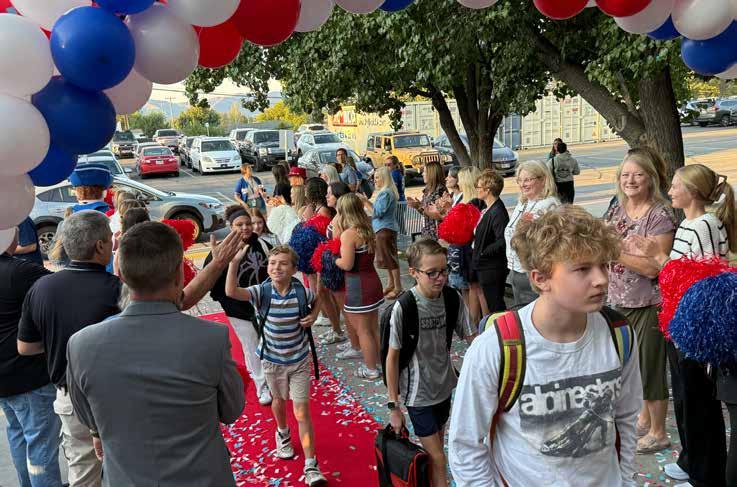
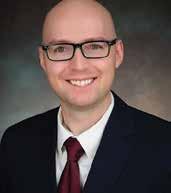
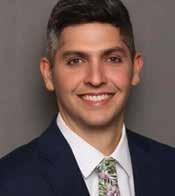






Halloween Safety 101: The Essential Guide for Parents and Homeowners.
By Holly Curby hello@hollycurby.com
With Halloween right around the corner, families are busy planning costumes, buying candy and decorating their homes. But amidst the excitement, safety should be a top priority. This festive night—meant for costumes and candy—can quickly take a dangerous turn if precautions aren’t taken. According to safety experts Judy Chavez from the U.S. Consumer Product Safety Commission and Amy Bryant, Crime Prevention Specialist with Sandy City Police, Halloween is one of the riskiest nights of the year for children and families.
Here’s how you can enjoy the frightful fun without real scares.
Costume Safety: Keep it Fun and Flame-Free
“Costumes should fit properly—not too long, loose or baggy,” Chavez said. “Long, flowing fabric can lead to trips and falls or even become a fire hazard if it brushes up against open flames like in Jack-o’-lanterns.”
When choosing costumes:
• Opt for flame-resistant materials like polyester or nylon.
• Avoid sheer cotton or rayon, which are more flammable.
• Add reflective tape or glow sticks to ensure visibility at night.
• Use hypoallergenic makeup and remem-
ber to remove it before bedtime—especially for kids with sensitive skin.
Chavez added, “Costume safety isn’t just about fire. It’s about preventing falls, rashes and other injuries we see every Halloween.”
Home Security: Don’t Let the Wrong Goblin In
Bryant reminds homeowners that Halloween isn’t just busy for trick-or-treaters— criminals may be lurking, too. “Keep all doors and windows locked, whether you’re home or not,” Bryant said. “Don’t assume because it’s a family night that everyone has good intentions.”
Other tips:
• Don’t open the door to strangers if you’re not expecting them.
• Teach kids not to answer the door without an adult’s permission.
• Install deadbolt locks with a 1.5-inch throw for added security.
• Use long screws in strike plates for stronger resistance to forced entry.
And don’t forget the garage. “Garage doors left open are an open invitation,” Bryant said. “Close and lock them—and if you’re going out of town, unplug the garage opener entirely.”
Porch Pirates Beware: Protect Your Packages
Halloween kicks off the holiday season, which often includes more online shopping and deliveries. “Track your packages and get them off the porch as soon as they arrive,” Bryant said. “Porch pirates are waiting for a

chance to snatch them.”
Consider having packages delivered:
• To your workplace
• To a trusted neighbor
• To a secure community locker
Also, let trusted neighbors know if you’ll be out of town. “They can keep an eye on things, collect packages, and even roll out your trash bins to make it look like you’re home,” she added.
Trick-or-Treating: Safety on the Streets Trick-or-treating is a highlight of Halloween—but it also poses risks, especially after dark.
Bryant emphasized: “An adult should always accompany children. Even if they think they’re old enough, parents need to be nearby.” According to Chavez, the CPSC estimates 3,600 Halloween-related injuries occurred in recent years, many due to falls, allergic reactions and decoration-related accidents.
To stay safe:
• Use sidewalks and crosswalks—never jaywalk.
• Make eye contact with drivers before crossing.
• Equip costumes with flashlights, glow sticks or reflective gear.
• Choose well-lit neighborhoods and avoid poorly lit areas.
“Motorists, too, need to do their part,” Bryant said. “Drive slowly, keep headlights on, and be extra cautious in residential areas.”
Don’t Let Decorations Become a Disaster
That adorable Jack-o’-lantern on your

porch? It might be a fire risk.
“If you use candles, never leave them unattended,” Chavez said. “Better yet, opt for battery-operated LED candles.”
Also:
• Bring in pumpkins and outdoor décor at the end of the night.
• Avoid leaving anything out that can be vandalized or used dangerously.
• Monitor any electrical decorations for exposed wires or overloading outlets.
Have Fun, Stay Safe
Halloween is meant to be fun—not hazardous. With the right precautions, families can enjoy the thrills of the season without becoming part of the injury statistics. As Chavez puts it, “It’s about making smart choices. We want Halloween to be memorable for the right reasons.” l




State’s top educator remains agile during shifts in education reform.
By Julie Slama j.slama@mycityjournals.com
Week one didn’t go as expected. Utah’s new State Superintendent of Public Instruction Molly Hart faced an unexpected challenge when President Donald Trump’s administration froze education funds that were set to be dispersed.
“It was surprising he froze funds that had already been approved through Congress,” she said. “I was anticipating changes, but I was anticipating them moving forward. So, when those changes happened a week into my tenure, it threw a wrench in the kickoff.”
Hart, who previously served as executive director of Summit Academy Schools for two and one-half years, hadn’t planned to follow in the footsteps of former superintendent Sydnee Dickson, who served for nine years. At Summit and as vice chair of the Utah State Board of Education, she felt she had found her place—working directly with students and leading through change.
“When opportunity comes, you got to answer the door,” said the veteran educator from Sandy. “I didn’t ever really see myself leaving a school setting where there were kids and I could be involved in an actual school day. I thought I hit the sweet spot, but opportunity knocks and to make a difference at this level, and to make things happen, how do you turn that down? It’s an exciting opportunity.”
It’s now been two months since Hart, a former teacher who served as principal at Mt. Jordan and Albion middle schools, was sworn in as state superintendent. She and Dickson collaborated to ensure a smooth transition in June into the K–12 summer break.
“I stay moving from 7 a.m. to 7 p.m. I haven’t even unpacked all my boxes. It’s back to school for USBE, just as it’s back to school for schools,” Hart said.
City Journals posed questions to Hart about key initiatives and pressing issues in education.
What was it like when the government froze funds?
The president was clear about his priorities all the way along. We did eventually get those funds, so districts are able to pay their summer programs’ and afterschool programs’ people.
A central tenet of Trump’s plan is to eliminate the federal department of education. Is it going to impact some of the programs, such as Title I schools and others?
There are three big federal education programs: the free and reduced lunch program, the Title I program and IDEA (Individuals with Disabilities Education Act) or special education. USDA already co-manages the lunch program along with department of education. The plan for the others, at one point, was to move them to other agencies, and the funding was to continue in some form. But other Title programs, like Title II (supporting effective instruction), Title III (language instruction for English learners and immigrant students) were the ones that were frozen. We’re now looking at the budget process moving forward for when we get federal funds. There are a lot of different timelines that intersect, and the U.S. Senate pushed back against some of the president’s proposals, so it’s just an evolving story with a shifting landscape. We have to stay agile, consider the information we have at any given time and be ready to improvise.
If the federal department of education fades away, is Utah OK to run our education system?
Many people don’t think it will completely fade away. The department of education may still exist, but it could be much smaller in size and scope. It would take congressional action for the department to “disappear.” Saying that, it was nowhere on my bingo card that funds would be frozen. And, there was nowhere on my bingo card that those funds would be unfrozen. What’s extraordinary about these times is the different paths and the uncertainty of the next action. The best thing I can do is help others prepare for contingencies. Utah is well positioned to manage and keep consistent educational opportunities for kids. The problem is always where the money comes from, when the money comes, and how the money comes, so whether it comes from the state or from local, or from federal, and how it comes, what kinds of strings are attached, what kinds of choices we get to
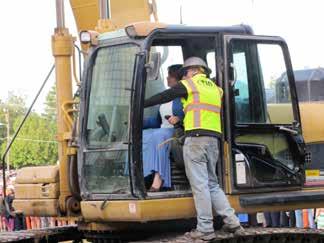

make, and how it’s administered. It’s a new game — and all those spaces are changing at the same time. At the end of the day, our teachers and principals are going to open schools this fall, and they are going to give students the best education out there.
Share your top priorities.
It’s important to me that we get the various constituents together. There’s been a fracturing of communication in education, and we’ve become very polarized needlessly. As state superintendent, I can bring disparate groups of people together and create synergy. It’s important the USBE is responsive, efficient and meeting the needs of the various stakeholders and also, communicating accurate data and information to the legislature, to the field and throughout the agency. It’s important we find ways to increase student achievement and knowledge and students come away knowing how to solve problems and knowing how to meet the needs of communities in the future. That is our goal and it’s important to me that stakeholders come together and keep that in our sights. We’re an agency of the government. We serve the people. We are servant leaders. We need to do that efficiently and without wasting resources, and we need to do it transparently.
Utah has 70,000 students. Many teachers and principals are concerned about low attendance. How can USBE help?
Molly Hart, now the state superintendent, received directions how to drive the excavator into the former Mt. Jordan school building to make way for a new school. (Julie Slama/City Journals)
Attendance is one of those things that can’t be solved with any one single approach. We’ve got to engage families and parents and understand why students aren’t coming to school and figure out where that disconnect is, and work on the experiences in school so that it’s a place students understand the need and what they get out of being there. It’s got
to come from not just the education community, but communities at large and at the individual level. It is individual students and their parents making a choice each day whether or not they’re going to attend. We’ve got a toolbox to support districts as they identify barriers and work to remove them. As a former principal, I do know there’s a lot a school can do, but I also understand the limitations of what a school can do and where a district or a state agency or the legislature or a community agency can have considerable impact on student rights and attendance rates. One thing we can do is look at schools at higher attendance rates and figure out what’s different between those and schools where attendance is an issue. There’s just a lot packed into attendance. It’s not simply missing a resource like a textbook. We need to look at everything. Does it have to do with transportation? Does it have to do with illness? Does it have to do with online learning? Is it a family priority or is there a barrier? Could it also be a data issue? There are a lot of questions to be answered.
What are some challenges facing our students in schools?
The changing workforce and what the workforce is going to need and what students are going to need to be prepared for the workforce is a challenge. Education spends a lot of time working with workforce, higher ed and workforce services industry partners to understand their needs, what they’d like to see our graduates be equipped with. A couple years ago, students were studying computer programming or data science and there were 1 million jobs. Well, here comes AI, and maybe some of those pieces can be outsourced, and the data scientist needs to have a whole different set of skills. That rate
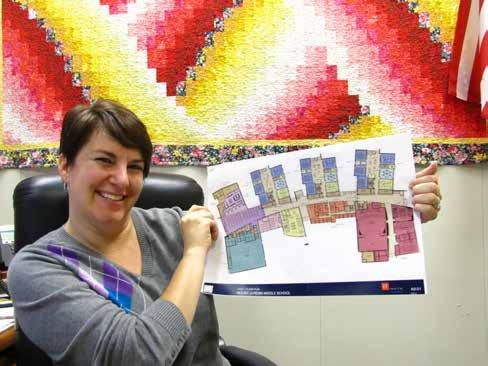
of change is accelerating, so it’s always a moving target. There’s a lot of movement of students geographically and making sure students information get from point A to point B safely, so there’s continuity in services and students can pick up where they leave off, pick up in one place where they leave off in another. That’s a challenge as well.
You have said as an educator, you love hearing from parents, getting feedback and having those conversations. How are you going to do it now?
I’m working on creating listening groups and listening tours. As the school year gets started, I’ll be traveling around, coordinating and attending focus group meetings, along with state board members and legislators and community partners and districts, intentionally hearing those (parents’) voices and asking those questions. My plan is to ask the local legislators, the local board members and the state board member to be part of it and make sure as many people want to attend, can attend. There would be two meetings in the same community — one to listen to parents and hearing what they have to say, and then a second, listening to teachers and educators to get feedback there. (Once set, the schedule will be posted on the USBE website and communicated through local districts and through school community councils.)
Utah spends less than $10,000 per student (ranked last in the country). Is more needed? If so, how are you going to get more and what is it needed for?
That is a huge question. We have to live within our means and if that’s what we get, then that’s what we get. We can’t spend more. Of course, we could use more, but it’s government money, which means it came from the people, so every time we ask for more, we’re asking people for it from their wallet.
What’s most important is that we’re using the money we do have in the best way possible. I can ask, ‘What are we getting for the money that we do spend? Are there things we’re spending more on, that maybe were needs of the past, but are not current needs?’ We need to make sure money is going to the right places. We want to use the money we do have in the best way possible for the best outcome to set up our students for success, whatever success looks like for them and their families.
Utah students are pushing graduation rates close to 90%; how does that compare to national standards?
It’s amazing. When I go to national activities or conferences or gatherings, Utah has the envy of a lot of states. At a national conference, one of our staff members shared our teacher retention rate (91% average retained in a single year) and people in the room gasped. We are doing really great things in Utah and I’m proud of the work we do in our communities and at our state level, but you just don’t settle. You just don’t. We’re going to keep on doing great things for our kids and as new situations and new realities emerge in our communities and in our workforce, then we adjust our practices accordingly. We keep looking forward for those opportunities and those teachable moments.
Utah is ahead of the national average on test scores. Can Utah students do better?
I’m very proud of the work our families and students do. Of course, we can do better, and, of course, I want them to do better and I’m going to push them to do better. There’s always room to grow. I like to be a little relentless with pushing everyone to be better; we don’t ever quit on kids. We keep moving forward and putting one foot in front of the other. I’m never going to say, ‘We’ve arrived’ and ‘It’s good enough.’ l

By Peri Kinder peri.k@thecityjournals.com
Marylee Wallwork said small businesses have always been the backbone of America. When she learned that her pizzeria, Wicked Peel, had won a Comcast RISE grant package, Wallwork thanked the corporation for investing in the mom-and-pop stores that make this country great.
“It’s the little family places and small shops that built this country,” Wallwork said. “It’s always good to see big corporations that actually think about the little guy. Comcast understands that you have to have the little guys out there for everyone to make it.”
Comcast awarded 100 grant packages to small businesses along the Wasatch Front to strengthen local communities and fuel growth. Along with $5,000, each recipient will receive a Comcast Business technology makeover, business coaching, media production and educational resources.
As the owner of Wicked Peel Pizza Kitchen, located at 3956 Innovation Drive in Riverton, Wallwork has survived several occurrences that could have tanked any other business.
After opening in 2018, she was just making headway when COVID hit. When she recovered from that, construction began at the 134000 South intersection on Bangerter Highway. Most recently, the Jordan Basin sewer upgrades have caused a lot of disruption.
“The last six months have been the hardest. There was a time when customers had to park down the street to come get my pizza,” she said. “All I know for sure is that we’re going to put [the grant] towards marketing to let people know that we’re still here. I want people to know they can get to us and make sure people know that we’re here to serve them really good food.”
Wicked Peel serves classic Italian cuisine, made from scratch with family recipes. It offers handmade pasta, wood-fired pizza, cheesy calzones, house-made meatballs and a caramel apple dessert pizza featuring apples, cinnamon crumbs, vanilla ice cream and caramel sauce. For more information and a complete menu, visit WickedPeel.com.
Riverton City Councilman Andy Pierucci is a big fan of Wicked Peel. He praised Wallwork on her commitment to community involvement and impact, despite challenges from local construction projects.
“Wicked Peel is a great member of our business community. They’re an awesome


small business right in the heart of our economy in the city,” Pierucci said. “I’m grateful for Comcast’s investment in small businesses because when they succeed, our community succeeds.”
Ken Neil, General Manager of Comcast Advertising, is excited to have his team work with Wallwork to create a custom advertising package. He knows Wallwork has struggled with visibility and he hopes to quickly change that.
“We can get her brand or product out into the marketplace that people will see,” he said. “We are the largest broadband provider in the state, so we get data. Then, we’re able to target the specific people she is trying to reach. It makes it efficient and minimizes the waste of advertising power.”
In addition to the Wasatch Front, grant
recipients were announced in four other regions: Boston; Grand Rapids, Michigan; Nashville, Tennessee; and Seattle, Washington, for a total of 500 recipients this year. To date, Comcast RISE has provided a total of $160 million in monetary, marketing and technology resources to 14,500 small businesses nationwide, underscoring Comcast’s belief that when small businesses thrive, communities thrive.
“Comcast RISE is about helping Utah’s small businesses not just survive, but thrive,” said Deneiva Knight, External Affairs Director, Comcast Mountain West Region. “By providing grants, marketing, and technology support, we’re investing in the entrepreneurs whose success fuels growth and opportunity across our communities.” l




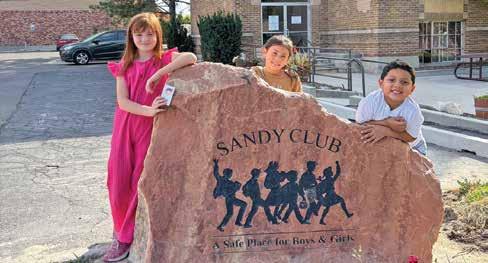
Congratulations to our September Members of the Month, Teagan Lawrence, Ruth Burner, & Emiliano Pineda-Ochoa! Teagan is 11 years old: Teagan is not sure yet on what she wants to become when he grows up. Teagan has been attending the Sandy Club for 1 year, in that time she has learned how to be kind. Ruth is 7 years old: she wants to become a teacher, she has been attending for 2 years, in that time she has learned the Sandy Club rules. Emiliano is 6 years old: he wants to become a construction worker, he has been attending for 1 year, and in that time, he has learned how to make friends.
CONGRATULATIONS ONCE AGAIN, WE ARE SO PROUD OF YOU ALL!







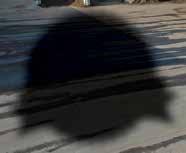





Volunteers craft menstrual care kits to help girls stay in school and live with dignity.
By Peri Kinder peri.k@thecityjournals.com
For
more than 500 million women and girls around the world, access to menstrual products is nonexistent. The term “period poverty” describes the struggle faced by people who don’t have adequate menstrual supplies and education.
Days for Girls is a global nonprofit offering dignity and health to women and girls by providing sustainable menstrual kits. Volunteers around the world sew, assemble and distribute the kits, allowing girls to stay in school, attend work and alleviate health concerns that arise when menstrual products are unavailable.
Suzanne Walker runs the Midvale chapter of Days for Girls, along with her friend Jennifer Woods and lots of volunteers. The chapter has created and distributed nearly 2,000 kits to Thailand, Mexico, Vietnam, Fiji, Morocco, Zimbabwe, Peru, Cambodia and Nepal.
“We not only sew components, we are also a source of outreach for our community,” Walker said. “We advocate on behalf of Days for Girls International, teaching about its mission and the reasons why there is a need for such an organization to exist. We also conduct
work events with local churches and business groups, in which they help create the kits that will then be distributed throughout the world.”
Days for Girls was started in 2008 by Celeste Mergens. She was working at a Kenyan orphanage and found that menstruating girls would sit on pieces of cardboard, often going without food. With cultural taboos around menstruation, some women and girls can’t attend school or work, or even go into a kitchen while on their period.
Mergens created washable, long-lasting pads and underwear, designed to last several years, giving the girls the freedom to leave their rooms, reclaim their dignity and potentially end the cycle of poverty.
“The evolution of this pattern for these kits has changed many times,” Woods said. “They keep making it better and better. They listen to the girls and the moms, and the feedback that people give, and they fix any issues.”
The kits contain two pairs of underwear, two reusable shields, eight absorbent liners, a washcloth and soap for cleaning, and a waterproof bag to hold everything. Colorful fabrics help normalize menstruation and the components dry quickly to allow the women and girls to manage their hygiene. The waterproof bags are also used as a washing device in places where water is scarce.
“Some girls and women walk miles and miles for water,” Woods said. “They have this very small amount of water to use for their

cooking and their cleaning, so these bags become little washing machines.”
Walker said it’s a lot of work to create the kits and they have specific instructions to follow to ensure the pieces work together. But she calls it a “labor of love” for the thousands of women and girls their kits have helped over the years. The group holds service projects several times a year, where volunteers sew kit components.
“Even in the United States, there are women who don’t have access to period prod-



ucts,” Walker said. “There are hundreds of stories of lives being changed through Days for Girls. I love going into my community and talking about it, because we don’t talk about it. I talk to a lot of young women’s groups and they are super embarrassed, but they have no idea how lucky they are.”
To learn about volunteering or donating to the Days for Girls Midvale chapter, visit the Facebook page @dfgmidvale. For information about the international organization, visit DaysForGirls.org. l






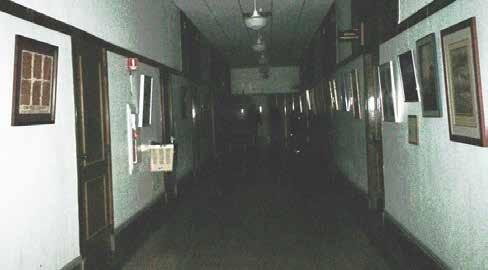
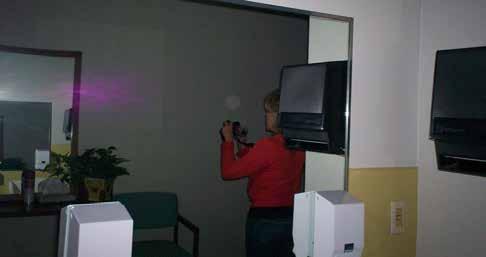
The Rio Grande Depot has been the subject of numerous haunting stories, most famously the legend of the “Purple Lady.” The Stone Tape theory attempts to explain why some locations seem to be more haunted than others.
By Collette Hayes c.hayes@mycityjournals.com
Whatif a building could remember every moment, every story and every experience that’s happened within its walls?
The Denver and Rio Grande Western Depot, constructed in 1910 in Salt Lake City, is known as one of the most beautiful and haunted buildings in Utah. Its exterior features a 5-foot-high base made of rare Colorado Yule marble complemented by brick and terra cotta above the marble base as well as a red tile roof. The interior of the depot is adorned with elegant marble finishes sourced from Kansas City. The combination of brick and stone construction provides the perfect medium for residual hauntings, which are often explained by the Stone Tape Theory. This theory suggests certain materials can “record” events that occur around them, serving as a common explanation for ghost sightings and apparitions.
The pseudoscientific Stone Tape Theory suggests that traumatic events can leave an imprint in stone, rock and brick. These materials are believed to be particularly effective at recording past events, which then can be “played back” like a recording. Limestone is considered the most effective of these materials. Marble, being a metamorphic rock derived from limestone, shares similar chemical properties, making it also highly effective in capturing past events. Sensitive individuals may be more attuned to the energy emanating from the stone in buildings, which could explain why only some people have experienced paranormal activity in the Rio Grande Depot.
The Stone Tape theory attempts to explain why certain locations seem to be more haunted than others, as well as why similar events tend to repeat in specific hauntings. It also provides insight into a common type of paranormal ex-
perience. Witnesses at the depot have reported seeing figures engaged in their daily activities, hearing disembodied sounds such as footsteps running down the hall, doors slamming, an emergency telephone ringing at 3 a.m., and lights turning on and off. Additionally, there have been sightings of a distressed woman dressed in purple in the second-floor ladies’ restroom, who has also been seen frequently near the café.
“While working in the Rio Grande offices, I never personally experienced anything out of the ordinary,” Deputy Director of the Utah Historical Society Kevin Fayles said in a recent conversation. “However, others have reported hearing the sound of running footsteps in the basement hallway. Also, I have an image of purple mist on the mirror in the ladies’ restroom, taken by a former employee. Another photo I have is looking down a hallway, where you see three faint figures. The building’s age could contribute to the feeling that it is haunted. I definitely wouldn’t want to be alone in the building at night.”
The Stone Tape Theory is compelling, but is backed by little scientific evidence. However, it does offer some explanation as to why individuals who have worked at the Rio Grande Depot have experienced similar events in the exact same locations.
An employee told Fayles that the Purple Lady was the creation of a former historical society colleague who had worked there long before Fayles took a position with the society. Apparently, the woman who invented the story believed that every train station should have a legendary ghost story. So, she fabricated a tale about a raven-haired beauty dressed in a purple pillbox hat, dress and matching heels. The story goes that the woman died under a train while trying to retrieve her engagement ring, that had been thrown on the tracks by her angry lover.
As reported in local media, the building has been the subject of numerous investigations including ghost hunters, psychic mediums and a séance performed by a Wiccan. The investigative findings fell a bit short of explaining the strange occurrences experienced by several employees at the Rio Grande Café.
Cafe staff have reported unusual incidents, such as hearing a woman singing in the
bathroom when the building was closed, experiencing flickering and turning off of lights, and receiving a 3 a.m. call from an emergency phone located in an empty elevator.
Also, Utah Department of Heritage & Arts Communication Director of Communications Josh Loftin noted that people have reported hearing footsteps on the upstairs balcony, sounds of talking or music playing, ghostly sightings upstairs and even alarms going off unexpectedly.
Paranormal historian Troy Taylor, author of more than 150 books on history, hauntings, true crime and host of the popular podcast “American Hauntings,” suggests that the vast majority of the paranormal cases he has been involved in have perfectly natural explanations. He says, “It is easy to feed off one another’s fears and literally ‘invent’ a haunted house.”
Although he admits, “I have been involved in some cases that did puzzle me and left me feeling that the location really was haunted.” He says to keep in mind, “When investigating a paranormal event, activity rarely occurs during an investigation.”
Residual hauntings can attempt to explain most of the haunting activities that have been reported at the depot. Digging a little deeper, though, what about the water taps that turn on and refuse to turn off, reported by an employee or the Rio Grande Depot Café employee who said she was repeatedly locked out of the building late at night with no explanation, or cold spots in the building with no apparent cause for the low temperature? And the most pressing question: Will the new renovation of the depot stir up even more haunting activity?
Jeff Hymas, Utah Department of Government Operations executive communications director said, “For more than five years, extensive efforts have been undertaken at the Rio Grande Depot to assess the damage caused by a March 2020 earthquake, and to make the necessary repairs. As part of this process, the Utah Division of Facilities Construction and Management is working to ensure the restoration of the building’s structural integrity and to protect against future seismic activity. The building remains closed to the public while construction activities continue.”
According to paranormal belief, renova-
tions in a haunted building can sometimes disturb spirits and lead to a significant increase in paranormal activity. While there is no scientific evidence to support this idea, many homeowners have shared ghost stories that describe this phenomenon. One common theory is that renovations can unsettle spirits that are attached to the building. The changes may feel like an invasion to an entity that considers the building its home, leading to the spirit becoming restless or agitated.
On January 7, 2021, Adrienne White, owner of House Genealogy, began renovating her newly purchased historic home in Sugar House. While working in the basement, White and her sister encountered an inexplicable, almost paranormal, occurrence: an unidentifiable noise resonated through the house. Quickly returning upstairs, they found nothing out of place nor evidence of an intruder. The experience prompted her sister to search for information about White’s home, which led to the discovery of an obituary for a woman who had passed in the house on January 7, 1976— exactly 45 years from the day the renovation had begun.
“I’m not a nonbeliever in paranormal activity, but I don’t believe 100% either. However, my sister sending me the obituary changed my life,” White said. “It sparked my curiosity about the people and events that came before us, prompting me to explore the history of my home and other homes throughout the city. Amazed and fulfilled by what I uncovered about my home, I launched House Genealogy in February 2022.”
According to Jerod Johnson, a principal for the structural engineering firm Reavley Engineers, the Rio Grande Depot suffered severe damage from the 5.7 magnitude earthquake in 2020. Those involved in the renovation project have stated it could require “several years” to complete.
It may be quite some time before it is known whether the Rio Grande Depot experiences a significant increase in paranormal activity as a result of the current renovation. When the doors reopen to the Rio Grande Depot, the suspense surrounding this possibility will welcome both the curious and the brave to explore its intriguing hauntings further. l
could opt for university credit from Southern Utah University. The free event was sponsored by The Clark & Christine Ivory Foundation, the Robert H. and Katherine B. Garff Foundation, Capita Financial, Zions Bank and Western Governors University.
By Julie Slama j.slama@mycityjournals.com
During a break between sessions at the Show Up for Teachers conference, Altara Elementary fourth-grade teacher Clifford Lowe stopped by the STEM Action Center booth—one of 120 offering curriculum ideas, resources and giveaways.
“The STEM Action Center booth was awesome; I got some cool stuff from them that I’ll incorporate into my classroom,” said the Canyons School District dual immersion teacher. “The community here is really big in helping and supporting teachers, and I’ve been networking with teachers from other districts, getting to know things they’ve done.”
Lowe also took advantage of a free massage and a coconut Creamie while gathering ideas for his classroom’s calming corner.
The full-day event, at the Mountain America Expo Center in Sandy, featured keynote speakers, 40 breakout sessions, and an exposition hall filled with businesses and organizations celebrating and supporting teachers. Session topics included classroom engagement, personal finance, nutrition and sleep, stress management, leadership and conflict resolution.
Afternoon keynote speaker Ron Clark, founder of the Ron Clark Academy in Atlanta, addressed the crowd, while local authors signed books and the “Superintendents of Rock”—including Jordan School District Superintendent Anthony Godfrey—performed live.
Attendees earned relicensure points from the Utah State Board of Education or
The exposition hall featured giveaways and discounts from organizations including Thread, Chatbooks, Beehive Meals, University of Utah Wellness Hub, RC Willey, Operation Literacy, Salt by Sabrina, Albion Fit, Symbol Arts, Felt Right, Beddy’s, Hogle Zoo and the Utah Shakespeare Festival.
At the BYU Arts Partnership booth, educators learned about the Native American Curriculum Initiative.
“It’s an initiative that partners with the eight sovereign nations in Utah to cocreate authentic and accurate lesson plans that teachers can teach to students in their classrooms,” said program coordinator Brenda Beyal. “We go to these sovereign nations and ask them, ‘What would you like the children of Utah to know about your tribe?’ All eight sovereign nations have said they want people to know they’re still here, they’re thriving, they’re resilient, and they continue to work to better their communities.”
Each nation then wanted to spotlight other points: the Paiutes highlighted their fight for federal recognition, the Northwestern Band of the Shoshone shared traditional songs, and the Navajo Nation emphasized the historical “Long Walk.”
“All these nations have stories or things they want people to know and we use the arts to help tell those stories—and teachers can use the lessons we’ve created on our website along with podcasts and other resources,” she said.
Nearby, the Special Olympics Utah booth promoted Unified Champion Schools. Boston Iacobazzi, college-growth coordinator, said at least five colleges, 85 high schools, 25 middle schools, and 35 elementary schools participate in programs pairing

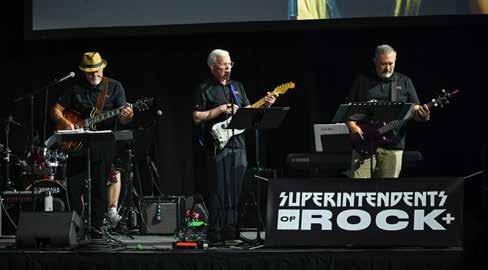
students with and without disabilities.
Special Olympics Utah CEO Scott Weaver said teachers were enthusiastic about the inclusive programming.
“We have gotten some positive feedback from teachers who currently have the program,” he said. “We just had a teacher in her second year rave about the leadership program with youth engagement and a lot
of these teachers see the value for their students, both for special education and regular ed students. It’s becoming a regular part of the school culture from reading together in elementary to playing sports, taking classes and becoming school leaders together. It’s rewarding to hear how inclusion is becoming part of the schools’ cultures.” l




Ruff Patch Rescue and Draper City Animal Services are just two examples of local animal welfare organizations that help find homes for pets and dispel negative myths about black cats.
By Katherine Weinstein k.weinstein@mycityjournals.com
Black cats experience lower adoption rates and higher euthanasia rates compared to other colored cats in animal shelters across the U.S. On a local level, however, things look a bit brighter for this symbol of Halloween. Ruff Patch Rescue and Draper City Animal Services are just two examples of area animal welfare organizations who work to find homes for all kinds of pets and help dispel negative myths about black cats.
“We actually get a lot of people who love black cats,” Jocelyn Callahan, a volunteer with Ruff Patch Rescue, said. “Kitties with more unique coloring, like Siamese and calicos, capture peoples’ eyes and often get adopted first. But black kitties aren’t always last. I think that once someone has a black cat and realizes how great they are, they want to adopt another.”
Anyone who has had the spooky ex-

perience of encountering a black cat in the dark, its eyes shining in the shadows, can appreciate how the animals became objects of superstition centuries ago. The notion that black cats bring bad luck is fading but is still one of the reasons why they have a harder time being adopted. Their dark fur also makes it more difficult for people to discern their features in shelters and it can be challenging to photograph black cats for adoption websites.
Officer A. Hurst at Draper City Animal Services acknowledged that black cats are often the last to be adopted. “But then there are people who are specifically looking for black cats,” she said, adding that all of her own pets are black.
A popular misconception about black cats is that animal welfare organizations usually suspend adoptions of the animals during the month of October out of concern that they will be harmed or discarded after Halloween. “That is a myth,” Hurst stated.
The ASPCA, the Humane Society of the United States and Best Friends Animal Society have issued statements in recent years declaring that there is no evidence that adopting black cats at Halloween poses a greater risk to the cats than adopting them at any other time of the year. Many shelters actually use Halloween to promote the


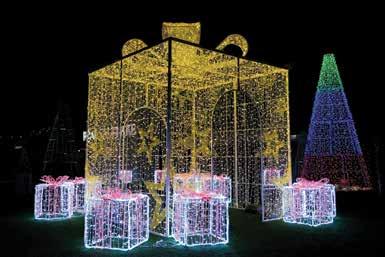

adoption of black cats.
Hurst, who has worked in the field of animal welfare in Utah and Colorado for over 20 years, said, “At the shelters I’ve worked for, we promoted the adoption of black cats at Halloween.” She added that some shelters give black cats Halloween-themed names to help get them adopted.
Callahan explained that Ruff Patch Rescue has a thorough vetting process for prospective adopters to help ensure that all pets go to homes where they will be safe and well taken care of. “We do have a contract in place,” she said. “We make sure that people are adopting for a reason. The whole family has to be involved.”
On a global scale, increased awareness of the plight of black cats in shelters is making a difference in how many find their forever homes. National Black Cat Appreciation Day, on Aug. 17 in the U.S. and National Black Cat Day, on Oct. 27 in the U.K., were founded to honor the value of black cats and dispel superstitions.
Last spring, NPR reported that adoptions of black cats increased thanks to the 2024 Academy Award-winning animated film, “Flow,” about a black cat who bonds with other animals to survive in a flooded world. “Anytime there’s a movie with a specific breed, there’s an uptick in adoptions,” Hurst said.
There are many pet rescue organizations and animal shelters in the Salt Lake
Valley filled with cats and dogs of all colors and breeds who are seeking homes. Ruff Patch Rescue, founded in Riverton, consists of a network of volunteers who foster all kinds of animals for adoption. They hold regular adoption events on Saturdays at the Riverton PetSmart. Visit ruffpatchrescue. com to see pictures of available pets.
Draper City Animal Services oversees a no-kill shelter. Lost pets without identifying tags or microchips are put up for adoption after a standard holding period of five business days. They are kept until they are adopted or eventually given to a pet rescue group. For more information, visit www. draperutah.gov/living-in-draper-city/animal-services/. l


My message is this:
I am a reless advocate for the community. District 1 ci zens and business owners deserve a City Council member who puts in the me and has a record of showing up for the people.
• I’ve come to over 2,500 of your doors.
• I learned the city ’s workings by aaending city council meeengs weekly.
• I have built strong relaeonships with current city council members and Sandy City Administraeon.
• I currently serve as a Sandy City Service Ambassador.
• I put in the eme to earn your trust.
Please vote for leadership that ’s visible, accessible, and responsible. Turn in your ballot for Shana Davis - a council member f member ocused on you and the future of Sandy.


feelings of
State health surveys show that nearly one in four Utah teens in 2023 and about 6% of adults in 2021 said they often or always felt, “People are around me but not with me.” That’s a sobering reminder that being surrounded by people is not the same as feeling connected to them.
The U.S. Surgeon General defines loneliness as the distress of not having adequate meaningful connections, while social isolation is the objective lack of social roles, relationships or interaction. Both are harmful. Loneliness raises the risk of premature death by 26%, and social isolation by 29%. Utah data show youth are particularly vulnerable, with loneliness peaking around 10th grade. At the other end of life, older adults may report less loneliness, but many live alone or are less socially active, leaving them isolated—and at increased health risk— even if they say they feel fine.
It’s not all bad news. Among adults, reported loneliness has risen from 5% in



2019 to 16% in 2024. While that increase seems alarming, some experts believe it reflects growing awareness. More people are recognizing that connection matters, which may encourage them to seek help or create new relationships. Meanwhile, Utah’s highest years for suicides (2017) and overdose deaths (2022) are behind us, with rates trending slightly down. We should not ignore loneliness, but perhaps our awareness is a hopeful step toward stronger, healthier communities.
Addressing loneliness requires all of us. Parents can set the stage at home by turning off screens, setting aside phones, listening closely, and modeling the conversations they hope their children will have with others. Simple family meals



and one-on-one time give youth safe spaces to share what they’re really experiencing.
Schools and businesses also play a role. Policies that encourage real connection—team projects, buddy systems, carpools, phone-free zones or mentoring programs—help students and employees build relationships that strengthen both well-being and performance. Identifying at-risk youth early and linking them with mentors can make a world of difference.
Local governments can create environments where connection naturally happens. Parks, libraries, recreation centers and public transportation all serve as “third spaces” where neighbors can meet. Programs like Salt Lake County’s Free Youth Rec Passes, summer events, farmers markets and free-fare zones lower barriers and invite people to gather. These aren’t just amenities; they are investments in the health and strength of our community.
Faith groups, sports teams and even traditions around food and gathering offer additional pathways. Whether it’s cheering together in the stands, sharing
a meal or volunteering at church, these experiences weave the fabric of community life. With creativity, we can support system-level changes that expand these opportunities in healthy ways.
In the end, the responsibility rests with each of us. Teens can choose to include someone sitting alone. Adults can prioritize friendships, check in on a neighbor or carve out time for family. Older adults can accept invitations or invite others into their routines. Each of these choices is small, but collectively they build the kind of community Salt Lake County is known for—caring, connected and resilient.
So I encourage you to pause and ask yourself: Am I truly connecting or just surrounded? Whether you are a student, a parent, a business leader or a retiree, you have the power to strengthen the web of relationships that hold us all together. In Salt Lake County, our greatest strength doesn’t come from policies or programs alone—it comes from people. When we choose connection, we choose health, hope and a brighter future for our community.



































Back in the day, it didn’t take much to be labeled a witch. Did you own a cat? Witch. Did you have a birthmark? Witch. Did you use herbs, wear a cape, know how to read or lure children into your gingerbread-flavored home so you could eat them for dinner? Witch.
I’m just saying, the bar was low. Starting in the 1450s, witch hysteria swept across Europe, lasting for centuries. Intense warfare, hardship, famine and disease meant only one thing: it was time to burn the witches, because obviously.
Nearly 60,000 people were tried and killed as witches. More than 80% were women and 60% were over the age of 40. It was a gendercide that wiped out generations of women. Many were healers, midwives, widows and property owners.
They’d reached a time in their lives where they were fine being alone, with maybe a cat or two. They just wanted a nice broom, a boiling cauldron of soup and a Pinterest board of “Witchy Reads.”
Many women step into their power once they hit 40, but give women power and there’s going to be trouble. Killing the older generations meant wisdom was lost forever, which is probably why we have mini golf sets for the toilet.
Like Labubu and Meta (and just as

diabolical), witch trials were big business. Women were arrested, property was seized and people flocked to churches because no one wants to accidentally sell their soul to Beelzebub.
The witch trials also created a disconnection between women; a fear of gathering, the angst of being seen as a “coven” when all you wanted to do was watch the “Real Housewives of Salem.” Women stopped socializing because having a friend for tea could end in a hanging. (And you thought your book club was stressful.)
I’m a lover of all things witchy, a devotee of strong women using their magic for good. A witch is a woman who speaks truth to power, without shame. Imagine a combination of Dolly Parton, Oprah Winfrey and Ruth Bader Ginsburg, a woman so powerful even the Puritans would have been like, “Nope, not today.”
You see, a witch hunt creates a cul-




ture that undervalues women. When you describe women as shrill, chatty, feisty, mousey, sassy, emotional, slutty, hysterical, irrational or hormonal, those words strip away power.
How many of these words are used to describe men? Almost zero. At the worst, men get labeled as “grumpy,” and somehow that becomes “distinguished.”
There’s still a witch hunt going on today. Saying “women’s rights” to certain groups triggers frothing at the mouth and a call for the ducking stool.
Women want to be believed, heard and have the ability to live without violence or discrimination. We want affordable physical and mental health care, an equal wage and respect. Is that insane, deranged, unhinged or any other word used to lock women up in asylums, as recently as 1967?
A witch stands on her own. She embraces her age, her knowledge and her intuition, without fear. It’s not surprising that interest in witchy practices is rising. You can learn spells on TikTok, craft a voodoo doll on YouTube and banish your ex to the depths of Detroit using a candle, cayenne pepper and a squeeze of lemon. Science, obviously.
For women who have felt disenfranchised in their communities, religions and


workplaces, witchy practices are a way to find their power. It isn’t an excuse to turn women into barbecue.
I associate magic with creation, and women are the ultimate creators. Women are magic, able to run empires, sing lullabies and look fabulous in a cape. Do you need someone to change the world for the better? Find a witch.



